LG Electronics USA H960 Multi-band GSM/EDGE/WCDMA/LTE Phone with WLAN, Bluetooth and RFID User Manual LG H960 English UG FCC Draft 150720 indd
LG Electronics MobileComm USA, Inc. Multi-band GSM/EDGE/WCDMA/LTE Phone with WLAN, Bluetooth and RFID LG H960 English UG FCC Draft 150720 indd
Users Manual
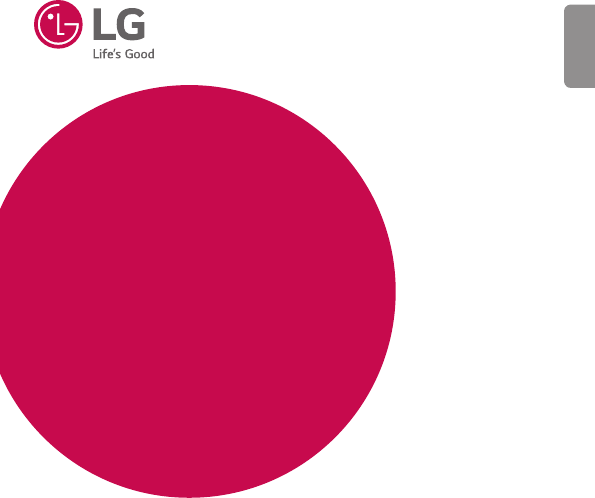
www.lg.com
MFL00000000 (1.0)
ENGLISH
USER GUIDE
LG-H960
User Guide
• Some contents and illustrations may differ from your device depending on the
region, service provider, software version, or OS version, and are subject to
change without prior notice.
• Always use genuine LG accessories. The supplied items are designed only for this
device and may not be compatible with other devices.
• This device is not suitable for people who have a visual impairment due to the
touchscreen keyboard.
• Copyright ©2015 LG Electronics, Inc. All rights reserved. LG and the LG logo are
registered trademarks of LG Group and its related entities. All other trademarks
are the property of their respective owners.
• Google™, Google Maps™, Gmail™, YouTube™, Hangouts™ and Play Store™
are trademarks of Google, Inc.
ENGLISH

2Table of contents
Guidelines for safe and effi cient use .......4
Important notice .....................................18
Getting to know your phone ...................21
Phone layout ..........................................21
Installing the SIM or USIM card and
battery ...................................................23
Charging the battery ..............................25
Inserting a memory card ........................26
Removing the memory card ...................27
Locking and unlocking the device ..........27
Your Home screen ...................................29
Touch screen tips ..................................29
Home screen .........................................30
Customizing the Home screen ...............31
Returning to recently-used
applications ........................................... 32
Notifi cations panel .................................33
On-screen keyboard ..............................36
Special Features .....................................37
Gesture shot ..........................................37
Gesture View .........................................38
Glance View ...........................................39
KnockON ...............................................39
Knock Code ...........................................40
Dual window..........................................41
QuickMemo+ .........................................42
QSlide ....................................................43
QuickRemote .........................................44
Google account setup .............................45
Creating your Google account ................45
Signing into your Google account ...........45
Connecting to Networks and Devices ....47
Wi-Fi .....................................................47
Bluetooth ...............................................48
Wi-Fi Direct ...........................................49
Transferring data between a PC and
the device ..............................................50
Calls ........................................................51
Making a call .........................................51
Calling your contacts .............................51
Answering and rejecting a call ...............51
Making a second call .............................52
Viewing your call logs ............................52
Call settings ...........................................52
Contacts ..................................................53
Searching for a contact ..........................53
Adding a new contact ............................53
Favourites contacts ................................53
Creating a group ....................................54
Messaging ............................................... 55
Sending a message ...............................55
Conversation view .................................56
Changing your messaging settings ........56
Table of contents

3
Table of contents
E-mail ......................................................57
Managing email accounts ......................57
Working with account folders .................57
Composing and sending email ...............58
Camera and Video ...................................59
Camera options on the viewfi nder ..........59
Using the advanced settings ..................60
Manual mode on the viewfi nder .............61
Taking a photo .......................................62
Once you have taken a photo .................62
Recording a video ..................................64
After recording a video...........................64
Gallery ................................................... 66
Multimedia ..............................................70
Music ....................................................70
Utilities ....................................................72
Clock .....................................................72
Calculator ..............................................73
Calendar ................................................ 73
Voice Recorder ......................................74
Voice Search..........................................74
Downloads ............................................74
FM radio ................................................75
LG Health ..............................................75
Web Browser ...........................................76
Internet .................................................. 76
Chrome .................................................77
Settings ...................................................78
Networks ...............................................78
Sound & notifi cation ..............................81
Display ..................................................82
General .................................................. 84
Phone software update ..........................91
Phone software update ..........................91
About this user guide .............................93
About this user guide .............................93
Trademarks ...........................................94
DivX HD .................................................94
Dolby Digital Plus ...................................94
Accessories .............................................95
Troubleshooting ......................................96
FAQ ..........................................................99
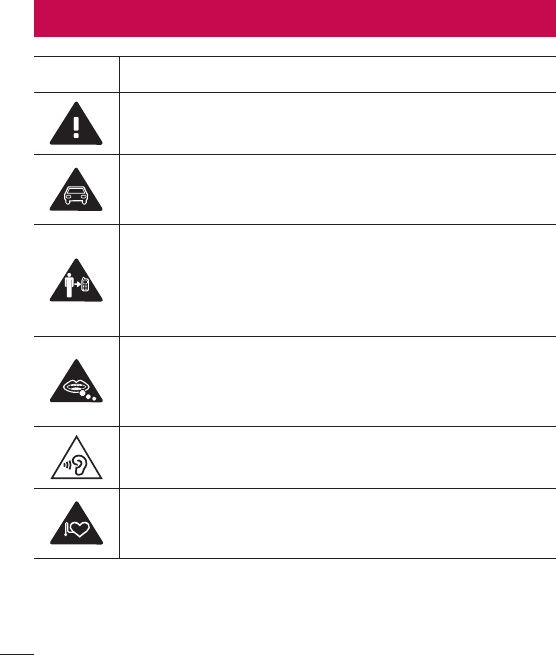
4Guidelines for safe and efficient use
Symbol Description
Read these instructions for safe use of this wireless device.
You must always exercise extreme caution when driving in order to
reduce the risk of accidents. Do not use your wireless device while
driving.
This device, moreover, has been tested for use at a distance of 1.5cm
between the back of the phone and the user's body.
To comply with RF exposure requirements established by the FCC, you
must maintain a minimum distance of 1cm between the user's body
and the back of the phone. See the user manual for more information.
Do not leave the device or its accessories within the reach of children
and do not allow to play with. The device contains small parts with
sharp edges that may cause injury or break off and give rise to danger
of suffocation.
This device may produce a loud sound.
Pacemaker manufacturers recommend that you leave at least 15cm
of space between other devices and a pacemaker to avoid potential
interference with the pacemaker.
Guidelines for safe and effi cient use
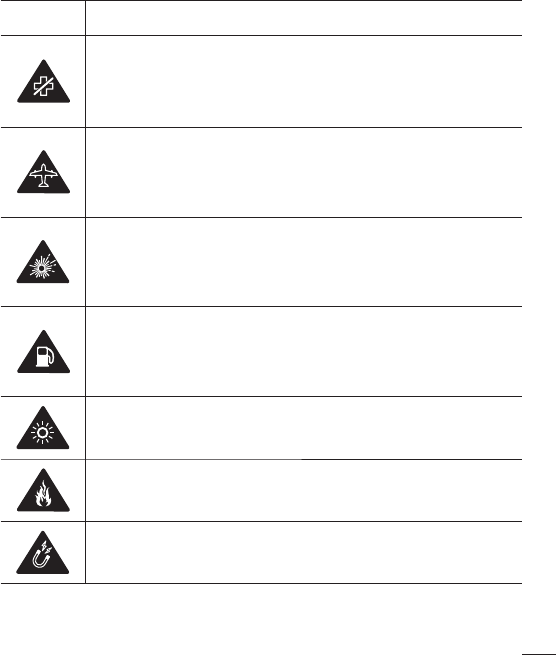
5
Guidelines for safe and efficient use
Symbol Description
Switch off your phone when prompted to do so in hospitals, clinics or
health care facilities.
These requests are designed to prevent possible interference with
sensitive medical devices.
Turn off your wireless device when prompted to do so by airport
personnel or aircraft. For information on the use of wireless devices on
board aircraft, contact the crew. If the device has a "flight mode", this
must be activated before boarding an aircraft.
Turn off the device or wireless device when in any area in which they
occur explosions or areas where there are reports that indicate to "turn
off two-way radio" or "electronic devices" to avoid interfering with the
operation of trigger explosions.
Among the areas with potentially explosive atmospheres include fueling
areas are, the holds of ships, facilities for the transportation or storage
of fuel and chemicals, areas where the air contains chemicals or
particles such as grain, dust or metal powders.
This device may produce a bright or flashing light.
Do not expose your device or its accessories to open flames.
Do not expose your device or its accessories to magnetic media (floppy
disks, credit cards, etc).
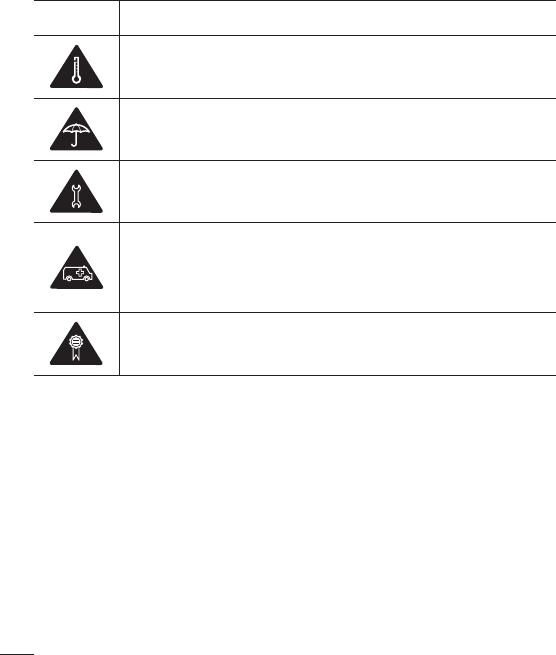
6Guidelines for safe and efficient use
Symbol Description
Do not expose your device or its accessories to extreme temperatures.
Do not expose your device or its accessories to liquid or moisture.
Not groped to disassemble the device or its accessories, only
authorized personnel can do it.
This device, like any wireless device, operates using radio signals
which, by their nature, are not able to guarantee connection in all
conditions. Therefore, for emergency communications, never rely solely
upon any wireless device.
Only use approved accessories.
Please read these simple guidelines. Not following these guidelines may be dangerous
or illegal.
Should a fault occur, a software tool is built into your device that will gather a fault log.
This tool gathers only data specific to the fault, such as signal strength, cell ID position
in sudden call drop and applications loaded. The log is used only to help determine the
cause of the fault. These logs are encrypted and can only be accessed by an authorised
LG Repair centre should you need to return your device for repair.

9
Guidelines for safe and efficient use
Product care and maintenance
WARNING
Always use genuine LG batteries, chargers and accessories approved for use
with this particular phone model. The use of any other types may void any
approval or warranty applying to the phone and may be dangerous.
• Do not disassemble this unit. Take it to a qualified service technician when repair
work is required.
• Repairs under warranty, at LG’s discretion, may include replacement parts or
boards that are either new or reconditioned, provided that they have functionality
equal to that of the parts being replaced.
• Keep away from electrical appliances such as TVs, radios and personal computers.
• The unit should be kept away from heat sources such as radiators or cookers.
• Do not drop.
• Do not subject this unit to mechanical vibration or shock.
• Switch off the phone in any area where you are required to by special regulations.
For example, do not use your phone in hospitals as it may affect sensitive medical
equipment.
• Do not handle the phone with wet hands while it is being charged. It may cause an
electric shock and can seriously damage your phone.
• Do not charge a handset near flammable material as the handset can become hot
and create a fire hazard.
• Use a dry cloth to clean the exterior of the unit (do not use solvents such as
benzene, thinner or alcohol).
• Do not charge the phone when it is on soft furnishings.
• The phone should be charged in a well ventilated area.
• Do not subject this unit to excessive smoke or dust.
• Do not keep the phone next to credit cards or transport tickets; it can affect the
information on the magnetic strips.

10 Guidelines for safe and efficient use
• Do not tap the screen with a sharp object as it may damage the phone.
• Do not expose the phone to liquid or moisture.
• Use accessories like earphones cautiously. Do not touch the antenna unnecessarily.
• Do not use, touch or attempt to remove or fix broken, chipped or cracked glass.
Damage to the glass display due to abuse or misuse is not covered under the
warranty.
• Your phone is an electronic device that generates heat during normal operation.
Extremely prolonged, direct skin contact in the absence of adequate ventilation
may result in discomfort or minor burns. Therefore, use care when handling your
phone during or immediately after operation.
• If your phone gets wet, immediately unplug it to dry off completely. Do not attempt
to accelerate the drying process with an external heating source, such as an oven,
microwave or hair dryer.
• The liquid in your wet phone, changes the colour of the product label inside your
phone. Damage to your device as a result of exposure to liquid is not covered
under your warranty.
Efficient phone operation
Electronics devices
All mobile phones may receive interference, which could affect performance.
• Do not use your mobile phone near medical equipment without requesting
permission. Please consult your doctor to determine if operation of your phone may
interfere with the operation of your medical device.
• Some hearing aids might be disturbed by mobile phones.
• Minor interference may affect TVs, radios, PCs etc.
• Use your phone in temperatures between 0°C and 40°C, if possible. Exposing
your phone to extremely low or high temperatures may result in damage,
malfunction, or even explosion.

11
Guidelines for safe and efficient use
Pacemakers
Pacemaker manufacturers recommend that a minimum separation of 15cm be
maintained between a mobile phone and a pacemaker to avoid potential interference
with the pacemaker. To achieve this use the phone on the opposite ear to your
pacemaker and do not carry it in a breast pocket.
Hospitals
Switch off your wireless device when requested to do so in hospitals, clinics or health
care facilities. These requests are designed to prevent possible interference with
sensitive medical equipment.
Road safety
Check the laws and regulations on the use of mobile phones in the area when you
drive.
• Do not use a hand-held phone while driving.
• Give full attention to driving.
• Use a hands-free kit, if available.
• Pull off the road and park before making or answering a call if driving conditions
require you to do so.
• RF energy may affect some electronic systems in your vehicle such as car stereos
and safety equipment.
• If your vehicle is equipped with an air bag, do not obstruct with installed or portable
wireless equipment. It can cause the air bag to fail or cause serious injury due to
improper performance.
• If you are listening to music while out and about, please ensure that the volume
is at a reasonable level so that you are aware of your surroundings. This is of
particular importance when near roads.

12 Guidelines for safe and efficient use
Avoid damage to your hearing
To prevent possible hearing damage, do not listen at high volume
levels for long periods.
Damage to your hearing can occur if you are exposed to loud sound for long periods of
time. We therefore recommend that you do not turn on or off the handset close to your
ear. We also recommend that music and call volumes are set to a reasonable level.
• When using headphones, turn the volume down if you cannot hear the people
speaking near you, or if the person sitting next to you can hear what you are
listening to.
NOTE
• Excessive sound pressure from earphones and headphones can cause
hearing loss.
Glass Parts
Some parts of your mobile device are made of glass. This glass could break if your
mobile device is dropped on a hard surface or receives a substantial impact. If the glass
breaks, do not touch or attempt to remove it. Stop using your mobile device until the
glass is replaced by an authorised service provider.
Blasting area
Do not use the phone where blasting is in progress. Observe restrictions and follow any
regulations or rules.

13
Guidelines for safe and efficient use
Potentially explosive atmospheres
• Do not use your phone at a refueling point.
• Do not use near fuel or chemicals.
• Do not transport or store flammable gas, liquid or explosives in the same
compartment of your vehicle as your mobile phone or accessories.
In aircraft
Wireless devices can cause interference in aircraft.
• Turn your mobile phone off before boarding any aircraft.
• Do not use it on the ground without permission from the crew.
Children
Keep the phone in a safe place out of the reach of small children. It includes small parts
which may cause a choking hazard if detached.
Emergency calls
Emergency calls may not be available on all mobile networks. Therefore you should
never depend solely on your phone for emergency calls. Check with your local service
provider.
Battery information and care
• You do not need to completely discharge the battery before recharging. Unlike
other battery systems, there is no memory effect that could compromise the
battery’s performance.
• Use only LG batteries and chargers. LG chargers are designed to maximise the
battery life.

14 Guidelines for safe and efficient use
• Do not disassemble or short-circuit the battery.
• Keep the metal contacts of the battery clean.
• Replace the battery when it no longer provides acceptable performance. The
battery pack may be recharged hundreds of times before it needs replacing.
• Recharge the battery if it has not been used for a long time to maximise usability.
• Do not expose the battery charger to direct sunlight or use it in high humidity, such
as in the bathroom.
• Do not leave the battery in hot or cold places, as this may deteriorate battery
performance.
• There is risk of explosion if the battery is replaced with an incorrect type.
• Dispose of used batteries according to the manufacturer’s instructions. Please
recycle when possible. Do not dispose as household waste.
• If you need to replace the battery, take it to the nearest authorised LG Electronics
service point or dealer for assistance.
• Always unplug the charger from the wall socket after the phone is fully charged to
save unnecessary power consumption of the charger.
• Actual battery life will depend on network configuration, product settings, usage
patterns, battery and environmental conditions.
• Make sure that no sharp-edged items such as animal’s teeth or nails, come into
contact with the battery. This could cause a fire.
Precautions for use of leather back cover
• This product is made of cattle hide and may have different creases and patterns
due to the properties of natural leather. If the product gets wet with any liquid
(water, soda, seawater, rain, sweat, sunscreen, cosmetics, moisture, etc.), it may
lose colour, change colour, or deform in shape.
• When this product gets wet or contaminated, get rid of the water by pressing it
gently with a dry towel, or wipe it with leather cream and leave it to dry in shade.
When the product is exposed to a wet environment for a long time, it may cause
creases or mould. The shape of the leather may not be restored to its original
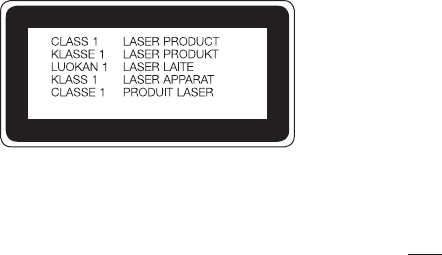
15
Guidelines for safe and efficient use
state after cleaning because of the properties of leather, and any contamination or
deformity may get worse when using regular detergent or an organic solvent.
• When the leather is wet with rain or sweat, use caution and avoid contact with
clothes. It can cause any dye to become a stain.
• Due to the nature of leather, friction for long periods of time or excessive force may
damage the surface of the leather.
Laser safety statement
Caution!
This product employs a laser system. To ensure proper use of this product, please read
this owner's manual carefully and retain for future reference. Should the unit require
maintenance, contact an authorised service centre.
Use of controls, adjustments, or the performance of procedures other than those
specified herein may result in hazardous radiation exposure.
To prevent direct exposure to laser beam, do not try to open the enclosure or make
direct contact with the laser.

16 Guidelines for safe and efficient use
Open Source Software Notice Information
To obtain the source code under GPL, LGPL, MPL, and other
open source licenses, that is contained in this product, please
visit http://opensource.lge.com.
In addition to the source code, all referred license terms, warranty
disclaimers and copyright notices are available for download.
LG Electronics will also provide open source code to you on CD-ROM for a
charge covering the cost of performing such distribution (such as the cost of
media, shipping, and handling) upon email request to opensource@lge.com.
This offer is valid for three (3) years from the date on which you purchased the
product.
HOW TO UPDATE YOUR DEVICE
Access to latest firmware releases, new software functions and
improvements.
• Select the software update in settings menu on your device.
• Update your device by connecting it to your PC. For more information
about using this function, please visit http://www.lg.com/common/index.jsp
select country and language.
DECLARATION OF CONFORMITY
Hereby, LG Electronics declares that this LG-H960 product is in compliance
with the essential requirements and other relevant provisions of Directive
1999/5/EC. A copy of theDeclaration of Conformity can be found at
http://www.lg.com/global/declaration
Contact office for compliance of this product:
LG Electronics Inc.
EU Representative, Krijgsman 1,
1186 DM Amstelveen, The Netherlands

17
Guidelines for safe and efficient use
Disposal of your old appliance
1 All electrical and electronic products should be disposed of separately
from the municipal waste stream via designated collection facilities
appointed by the government or the local authorities.
2 The correct disposal of your old appliance will help prevent potential
negative consequences for the environment and human health.
3 For more detailed information about disposal of your old appliance,
please contact your city office, waste disposal service or the shop
where you purchased the product.
Disposal of waste batteries/accumulators
1 This symbol may be combined with chemical symbols for mercury (Hg),
cadmium (Cd) or lead (Pb) if the battery contains more than 0.0005%
of mercury, 0.002% of cadmium or 0.004% of lead.
2 All batteries/accumulators should be disposed separately from the
municipal waste stream via designated collection facilities appointed by
the government or the local authorities.
3 The correct disposal of your old batteries/accumulators will help to
prevent potential negative consequences for the environment, animal
and human health.
4 For more detailed information about disposal of your old batteries/
accumulators, please contact your city office, waste disposal service or
the shop where you purchased the product.

18 Important notice
Please read this before you start using your phone!
Please check to see whether any problems you encountered with your phone are
described in this section before taking the phone in for service or calling a service
representative.
1. Phone memory
When there is less than 10MB of space available in your phone memory, your phone
cannot receive new messages. You may need to check your phone memory and delete
some data, such as applications or messages, to make more memory available.
To uninstall applications:
1 Tap > > > General tab > Apps.
2 Once all applications appear, scroll to and select the application you want to
uninstall.
3 Tap Uninstall.
2. Optimizing battery life
Extend your battery's power by turning off features that you do not need to run
constantly in the background. You can monitor how applications and system resources
consume battery power.
Extending your phone's battery life:
• Turn off radio communications when you are not using. If you are not using Wi-Fi,
Bluetooth or GPS, turn them off.
• Reduce screen brightness and set a shorter screen timeout.
• Turn off automatic syncing for Gmail, Calendar, Contacts and other applications.
Important notice

19
Important notice
• Some applications you download may consume battery power.
• While using downloaded applications, check the battery charge level.
3. Before installing an open source application and OS
WARNING
• If you install and use an OS other than the one provided by the manufacturer
it may cause your phone to malfunction. In addition, your phone will no
longer be covered by the warranty.
• To protect your phone and personal data, only download applications from
trusted sources, such as Play Store™. If there are improperly installed
applications on your phone, the phone may not work normally or a serious
error may occur. You must uninstall those applications and all associated
data and settings from the phone.
4. Opening and switching applications
Multitasking is easy with Android; you can keep more than one application running at
the same time. There is no need to quit an application before opening another. Use and
switch between several open applications. Android manages each application, stopping
and starting them as needed to make sure that idle applications don't consume
resources unnecessarily.
1 Tap . A list of recently used applications will be displayed.
2 Tap the application you want to access. This does not stop the previous app from
running in the background. Make sure to tap to back out of an app after using it.
• To close an app from the recent apps list, swipe the app preview to the left or right.
To clear all apps, tap Clear all.

20 Important notice
5. When the screen freezes
If the screen freezes or the phone does not respond when you try to operate it, remove
the battery and reinsert it. Then power the phone back on.
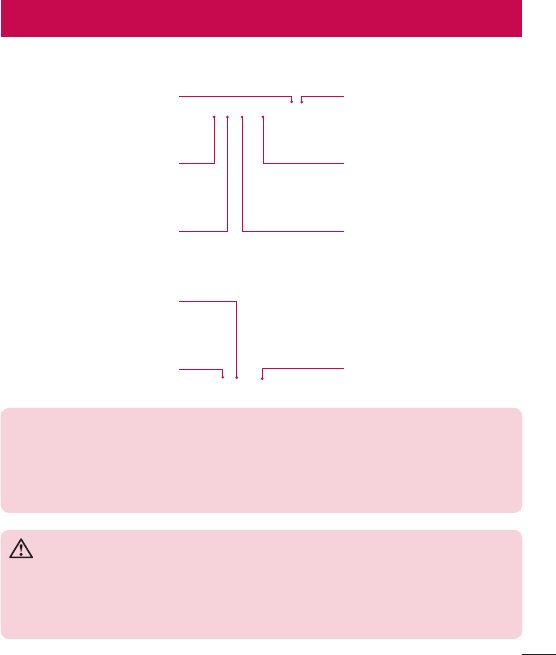
21
Getting to know your phone
Phone layout
Earpiece
Proximity SensorFront Camera Lens
Notification LED
Headset Jack
Microphone
Charger/USB port
Microphone
Infrared LED
NOTE: Proximity sensor
• When receiving and making calls, the proximity sensor automatically turns
the backlight off and locks the touch screen by sensing when the phone is
near your ear. This extends battery life and prevents you from unintentionally
activating the touch screen during calls.
WARNING
Placing a heavy object on the phone or sitting on it can damage the display
and touch screen functions. Do not cover the proximity sensor with screen
protectors or any other type of protective film. This could cause the sensor to
malfunction.
Getting to know your phone
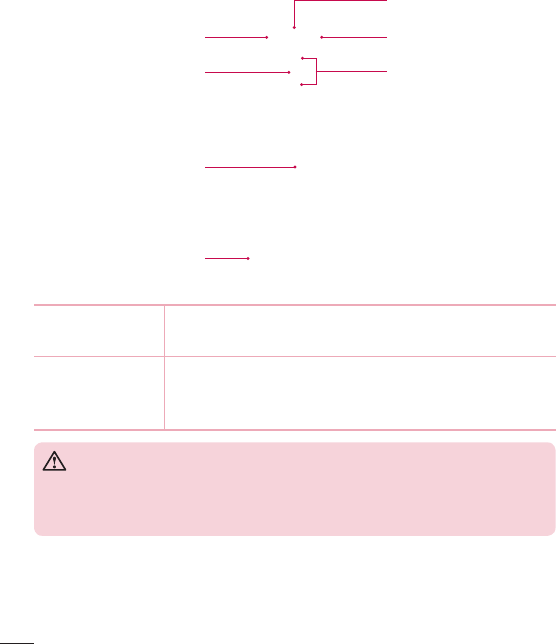
22 Getting to know your phone
Volume Keys
Power/Lock Key
NFC Touch Point
Laser Detection
AutoFocus
Speaker
Rear Camera Lens
Flash
Power/Lock Key • Turn your phone on/off by pressing and holding this key.
• Short press to lock/unlock the screen
Volume Keys (While screen is off)
• Press Volume Up Key twice to launch QuickMemo+
• Press Volume Down Key twice to launch Camera
WARNING
• The NFC antenna for this model is on the back cover.
• Be careful not to damage the NFC touch point on the phone, which is part
of the NFC antenna.

23
Getting to know your phone
Installing the SIM or USIM card and battery
Insert the SIM or USIM card provided by the mobile telephone service provider, and the
included battery.
1 To remove the back cover, hold the phone firmly in one hand. With your other hand,
lift off the back cover with your thumbnail as shown in the figure below.
2 Slide the SIM card into the SIM card slot as shown in the figure. Make sure the gold
contact area on the card is facing downward.

24 Getting to know your phone
WARNING
Do not insert a memory card into the SIM card slot. If a memory card
happens to be lodged in the SIM card slot, take the device to a LG Service
Centre to remove the memory card.
NOTE
• Only the microSIM cards work with the device.
3 Insert the battery.
4 To replace the cover onto the device, align the back cover over the battery
compartment and press it down until it clicks into place .

25
Getting to know your phone
Charging the battery
Charge the battery before using it for first time. Use the charger to charge the battery.
A computer can also be used to charge the battery by connecting the phone to it using
the USB cable.
WARNING
Use only LG-approved chargers, batteries and cables. If you use unapproved
chargers, batteries or cables, it may cause battery charging delay. Or this can
cause the battery to explode or damage the device, which are not covered by
the warranty.
The charger connector is located at the bottom of the phone. Insert the charger and
plug it into a power outlet.
NOTE
• Do not open the back cover while your phone is charging.

26 Getting to know your phone
Inserting a memory card
Your device supports up to a 2TB microSD card. Depending on the memory card
manufacturer and type, some memory cards may not be compatible with your device.
WARNING
Some memory cards may not be fully compatible with the device. Using an
incompatible card may damage the device or the memory card, or corrupt the
data stored in it.
NOTE
• Frequent writing and erasing of data shortens the lifespan of memory cards.
1 Remove the back cover.
2 Insert a memory card with the gold-coloured contacts facing downwards.
3 Replace the back cover.
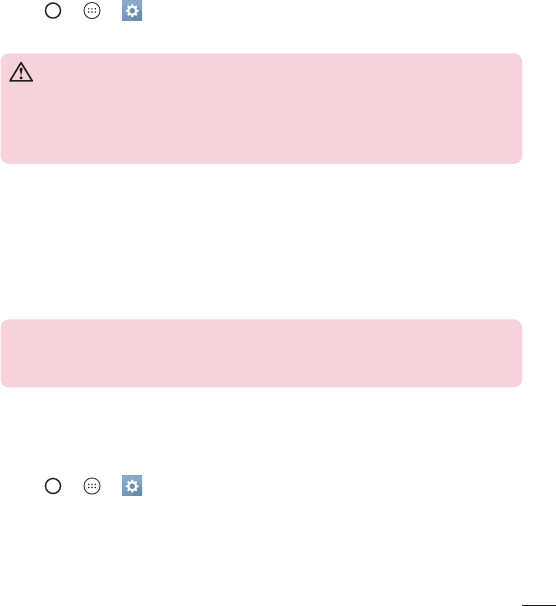
27
Getting to know your phone
Removing the memory card
Before removing the memory card, first unmount it for safe removal.
1 Tap > > > General tab > Storage > Unmount SD card.
2 Remove the back cover and pull out the memory card.
WARNING
Do not remove the memory card while the device is transferring or accessing
information. Doing so can cause data to be lost or corrupted or damage to
the memory card or device. It is not responsible for losses that result from the
misuse of damaged memory cards, including the loss of data.
Locking and unlocking the device
Pressing the Power/Lock Key turns off the screen and puts the device into lock mode.
The device automatically gets locked if it is not used for a specified period. This helps to
prevent accidental taps and saves battery power.
To unlock the device, press the Power/Lock Key and swipe the screen in any direction.
NOTE
• Double-tapping on the screen also can wake up the screen instead of the
Power/Lock Key.
Changing the screen lock method
You can change the way that you lock the screen to prevent others accessing your
personal information.
1 Tap > > > Display tab > Lock screen > Select screen lock.
2 Select a desired screen lock from None, Swipe, Knock Code, Pattern, PIN and
Password.

28 Getting to know your phone
NOTE
• Create a Google account before setting an unlock pattern and remember
the Backup PIN you created when creating your pattern lock.
Caution! If you haven't created a Google account on the phone and you
forgot your PIN, Password, and the backup PIN, you need to perform a
hard reset. But if you perform a hard reset, all user applications and user
data will be deleted. Please remember to back up any important data before
performing a hard reset.
TIP! Smart Lock
You can use Smart Lock to make unlocking your phone easier. You can set
it to keep your phone unlocked when you have a trusted Bluetooth device
connected to it, when it's in a familiar location like your home or work, or
when it recognises your face.
Setting up Smart Lock
1 Tap > > .
2 Tap Display tab > Lock screen > Smart Lock.
3 Before you add any trusted devices, trusted places, or trusted face, you
need to set up a screen lock (Pattern, PIN or Password).

29
Your Home screen
Touch screen tips
Here are some tips on how to navigate on your phone.
• Tap or touch – A single finger tap selects items, links, shortcuts and letters on the
on-screen keyboard.
• Touch and hold – Touch and hold an item on the screen by tapping it and not
lifting your finger until an action occurs.
• Drag – Touch and hold an item for a moment and then, without lifting your finger,
move your finger on the screen until you reach the target position. You can drag
items on the Home screen to reposition them.
• Swipe or slide – To swipe or slide, quickly move your finger across the surface
of the screen, without pausing when you first tap it (so you don't drag an item
instead).
• Double-tap – Double-tap to zoom on a webpage or a map.
• Pinch-to-Zoom – Use your index finger and thumb in a pinching or spreading
motion to zoom in or out when using the browser, Maps, or when viewing pictures.
• Rotate the screen – From many applications and menus, the screen orientation
adjusts to the device's physical orientation.
NOTE
• Do not press too hard; the tap screen is sensitive enough to pick up a light,
yet firm tap.
• Use the tip of your finger to tap the option you want. Be careful not to tap
any other buttons.
Your Home screen
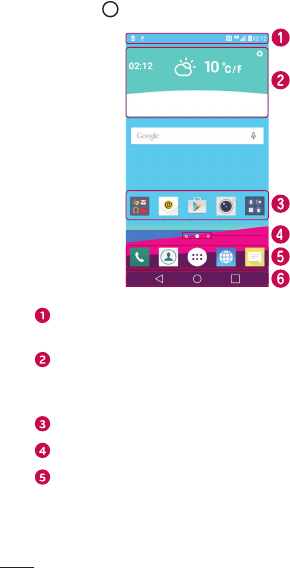
30 Your Home screen
Home screen
The Home screen is the starting point for many applications and functions. It allows
you to add items like app shortcuts and Google widgets to give you instant access to
information and applications. This is the default canvas and accessible from any menu
by tapping .
Status Bar
Widget
Application Icons
Location Indicator
Quick Button Area
Home touch Buttons
Shows phone’s status information, including the time, signal strength, battery status
and notification icons.
Widgets are self-contained applications that can be accessed through the Apps
drawer or on the Home screen. Unlike a shortcut, a Widget can function as an
on-screen application.
Tap an icon (application, folder, etc.) to open and use it.
Indicates which Home screen canvas you are currently viewing.
Provides one-touch access to the function in any Home screen canvas.
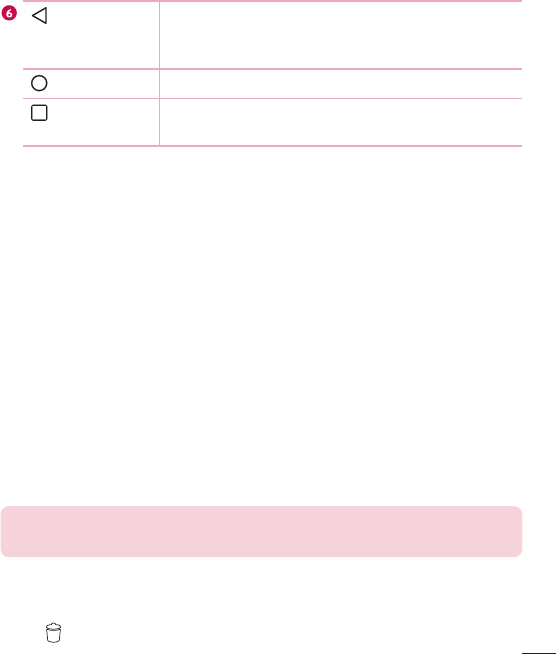
31
Your Home screen
Back Button Returns to the previous screen. Also closes pop-up
items, such as menus, dialogue boxes and the on-screen
keyboard.
Home Button Return to the Home screen from any screen.
Recent Apps
Button
Displays recently used applications. If you touch and hold
this Button, it opens a menu of available options.
Extended Home screen
The operating system provides multiple Home screen canvases to provide more space
for adding icons, widgets and more.
• Slide your finger left or right across the Home screen to access additional
canvases.
Customizing the Home screen
You can customise your Home screen by adding apps and widgets and changing
wallpapers.
Adding items on your Home screen
1 Touch and hold the empty part of the Home screen.
2 In the Add Mode menu, select the item you want to add. You then see this added
item on the Home screen.
3 Drag it to the desired location and lift your finger.
TIP! To add an application icon to the Home screen from the Apps screen,
touch and hold the application you want to add.
Removing an item from the Home screen
• While on the Home screen, touch and hold the icon you want to remove > drag it
to .
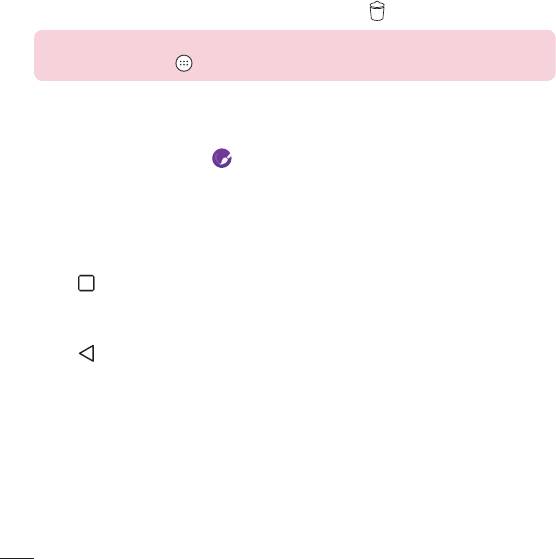
32 Your Home screen
Adding an app to the Quick Button Area
• From the Apps screen or on the Home screen, touch and hold an application icon
and drag it to the Quick Button Area. Then release it in the desired location.
Removing an app from the Quick Button Area
• Touch and hold the desired Quick Button, drag it to .
NOTE
• The Apps Button cannot be removed.
Customizing app icons on the Home screen
1 Touch and hold an application icon until it unlocks from its current position, then
release it. The editing icon appears in the upper-right corner of the application.
2 Tap the application icon again and select the desired icon design and size.
3 Tap OK to save the change.
Returning to recently-used applications
1 Tap . App previews of recently used applications will be displayed.
2 Tap an app preview to open the application.
- OR -
Tap to return to your previous screen.
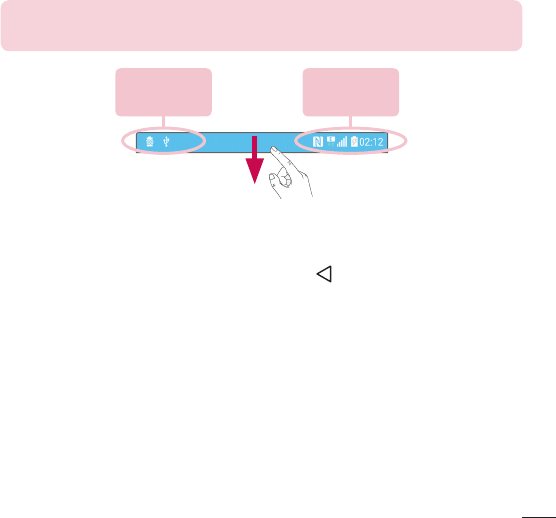
33
Your Home screen
Notifications panel
Notifications alert you to the arrival of new messages, calendar events and alarms, as
well as ongoing events, such as when you are on a call.
When a notification arrives, its icon appears at the top of the screen. Icons for pending
notifications appear on the left, and system icons, such as Wi-Fi and battery strength
are shown on the right.
NOTE
• The available options may vary depending on the region or service provider.
Pending
notifications
System
notifications
Opening the notifications panel
Swipe down from the status bar to open the notifications panel. To close the
notifications panel, swipe the screen upwards or tap .
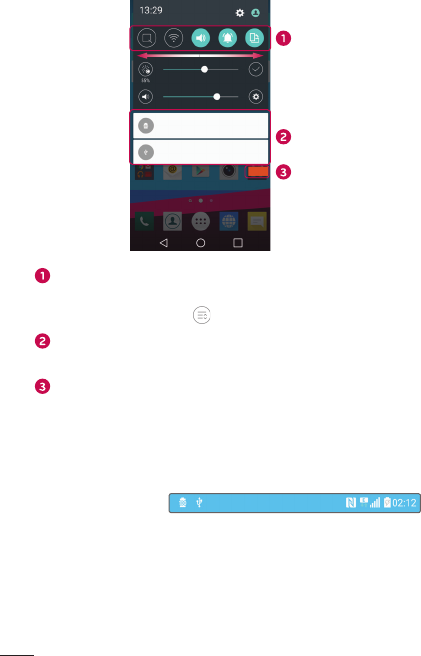
34 Your Home screen
Quick Settings Area
Notifications
Clear
Tap each quick setting button to toggle it on/off. Touch and hold the desired button
to directly access the settings menu for the function. To see more toggle buttons,
swipe left or right. Tap to remove, add or rearrange quick setting buttons.
Current notifications are listed, each with a brief description. Tap a notification to
view it.
Tap to clear all the notifications.
Indicator icons on the Status Bar
Indicator icons appear on the status bar at the top of the screen to report missed calls,
new messages, calendar events, device status and more.
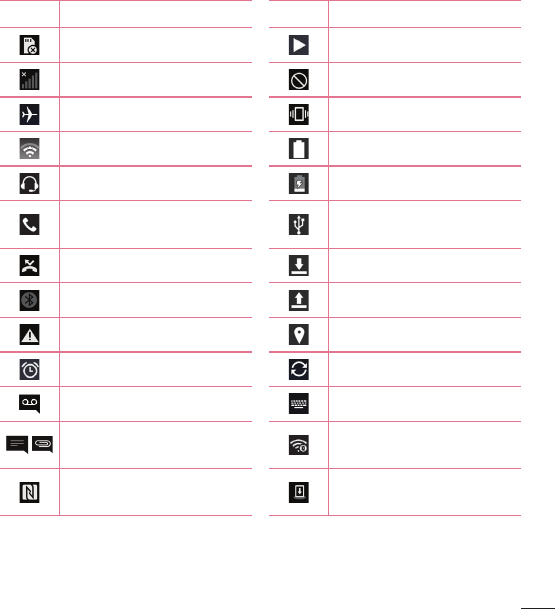
35
Your Home screen
The icons displayed at the top of the screen provide information about the status of the
device. The icons listed in the table below are some of the most common ones.
Icon Description Icon Description
No SIM card inserted A song is currently playing
No network signal available No Interruptions
Airplane mode is on Vibrate mode is on
Connected to a Wi-Fi network Battery fully charged
Wired headset connected Battery is charging
Call in progress The phone is connected to a
PC via a USB cable
Missed call Downloading data
Bluetooth is on Uploading data
System warning GPS is on
An alarm is set Data is synchronizing
New voicemail available Choose input method
New text or multimedia
message Wi-Fi hotspot is active
NFC is on Media server content sharing
is on

36 Your Home screen
NOTE
• The icon's location in the status bar may differ according to the function or
service.
On-screen keyboard
You can enter text using the on-screen keyboard. The on-screen keyboard appears on
the screen when you tap an available text entry field.
Using the keypad and entering text
Tap once to capitalise the next letter you type. Double-tap for all caps.
Tap to go to the keyboard settings. Touch and hold to change entering text method.
Tap to enter a space.
Tap to create a new line.
Tap to delete the previous character.
Entering accented letters
When you select French or Spanish as the text entry language, you can enter special
French or Spanish characters (e.g. "á").
For example, to input "á", touch and hold the "a" key until the zoom-in key expands
and displays characters from different languages. Then select the special character you
want.

37
Special Features
Gesture shot
The Gesture shot feature allows you to take a picture with a hand gesture using the
front camera.
To take a photo
There are two methods for using the Gesture shot feature.
• Raise your hand, with an open palm, until the front camera detects it and a box
appears on the screen. Then close your hand into a fist to start the timer, allowing
you time to get ready.
- OR -
• Raise your hand, in a clenched fist, until the front camera detects it and a box
appears on the screen. Then unclench your fist to start the timer, allowing you time
to get ready.
- OR -
TIP! Interval shot
If you make a fist twice or touch and hold , the camera consecutively takes
4 photos at a time.
Special Features
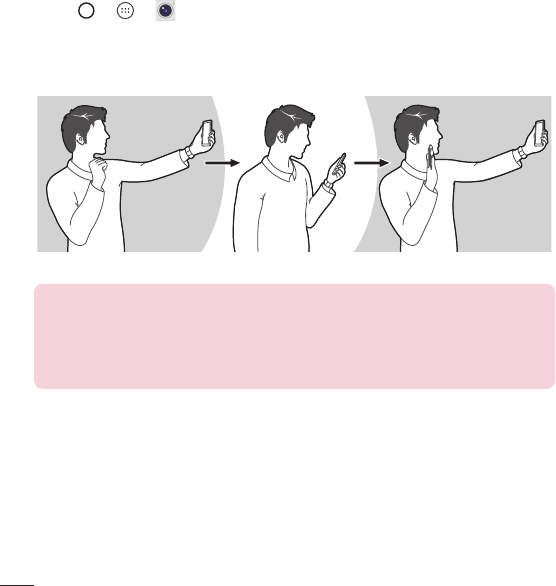
38 Special Features
Gesture View
After taking a photo with the front camera lens, you can automatically check the
captured photo with this gesture.
1 Tap > > .
2 Take a picture with the front camera.
3 After taking the picture, bring the phone close to your face. The captured photo will
be displayed.
Taking a picture Quick preview Returning front camera mode
NOTE
• Depends on the speed and angle of the gesture, this feature may not work
properly.
• When the angle is changed after Quick preview, it will go back to the camera
mode. You should go to Gallery to view the picture again.
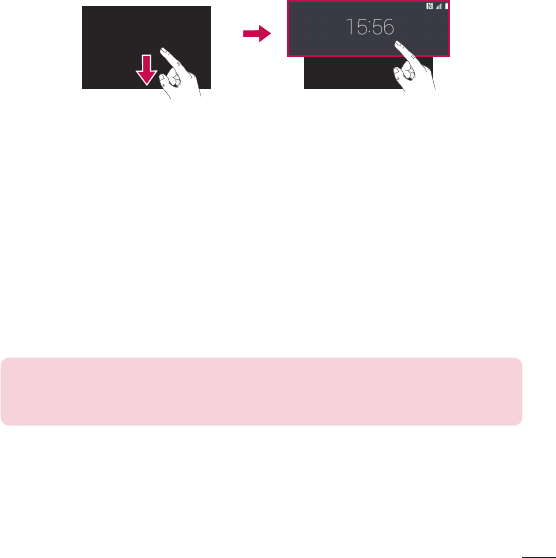
39
Special Features
Glance View
When the phone screen is off, you can see the status bar, time and date by dragging
your finger down on the screen.
KnockON
The KnockON feature allows you to double-tap the screen to easily turn it on or off.
To turn the screen on
1 Double-tap the centre of the Lock screen to turn the screen on.
2 Unlock the screen or access any of the available shortcuts or widgets.
To turn the screen off
1 Double-tap an empty area of the Home screen or the Status Bar.
2 The screen will turn off.
NOTE
• Tap on the centre area of the screen. If you tap on the bottom or the top
area, the recognition rate may decrease.

40 Special Features
Knock Code
The Knock Code feature allows you to create your own unlock code using a
combination of knocks on the screen. You can access the Home screen directly when
the screen is off by tapping the same sequence on the screen.
NOTE
• If you enter the wrong Knock Code 6 times, it will compulsorily take you to
your Google account log in/backup PIN.
• Use the fingertip instead of finger nail to tap the screen for turning it on or
off.
1 Tap > > > Display tab > Lock screen > Select screen lock >
Knock Code.
2 Tap the squares in a pattern to set your Knock Code. Your Knock Code pattern can
be 3 to 8 taps.
Unlocking the screen using the Knock Code
You can unlock the screen by tapping the Knock Code pattern you already set, when
the screen turns off.
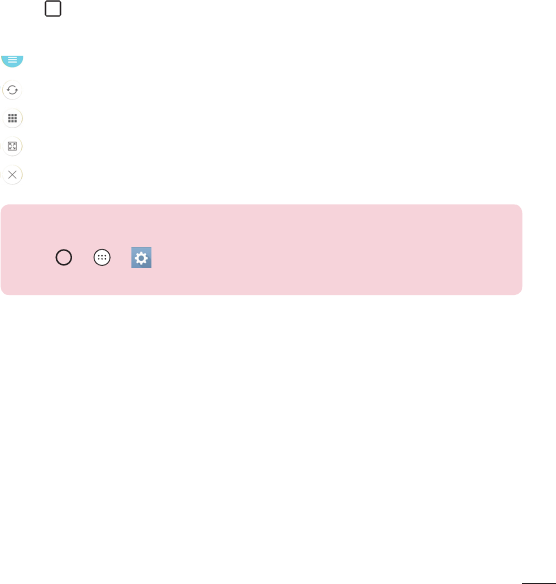
41
Special Features
Dual window
This feature allows you to multi-task by splitting up the screen into two, allowing you to
use two compatible applications at the same time.
1 Tap > Dual window.
2 Tap or drag the app icon for the corresponding application you wish to use.
: Tap to view the Dual window menu options, or drag to resize the split screens.
: Switch two screens.
: View the app list.
: Change the selected window to full screen.
: Close the currently selected app window.
NOTE
• You can enable or disable Dual window through the Settings menu.
1 Tap > > > General tab > Dual window.
2 Slide the toggle key to On or Off.
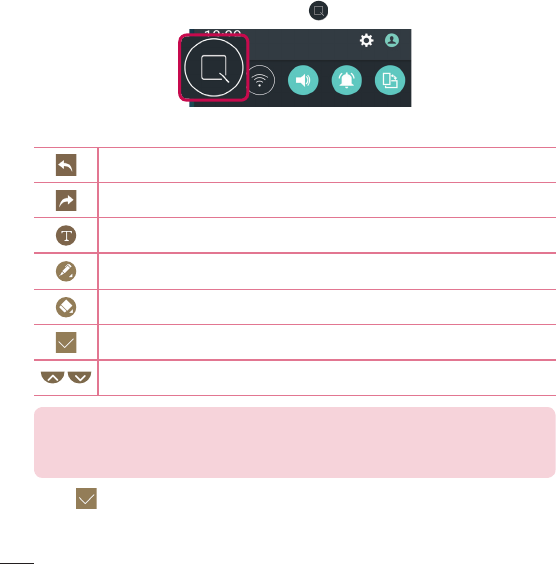
42 Special Features
QuickMemo+
The QuickMemo+ feature allows you to create memos and capture screen shots.
You can use QuickMemo+ to easily and efficiently create memos during a call, with a
saved picture or on the current phone screen.
1 Tap and drag the Status Bar down and tap .
2 Create a memo using the following options:
Tap to undo the most recent action.
Tap to redo the most recently deleted action.
Tap to insert text into your memo.
Tap to select the pen type and colour.
Tap to use the eraser to erase the pen marks on the memo.
Tap to save the memo you've created.
Tap to hide or display the toolbar.
NOTE
• Please use a fingertip while using the QuickMemo+ feature. Do not use your
fingernail.
3 Tap to save the current memo to the QuickMemo+ or Gallery.
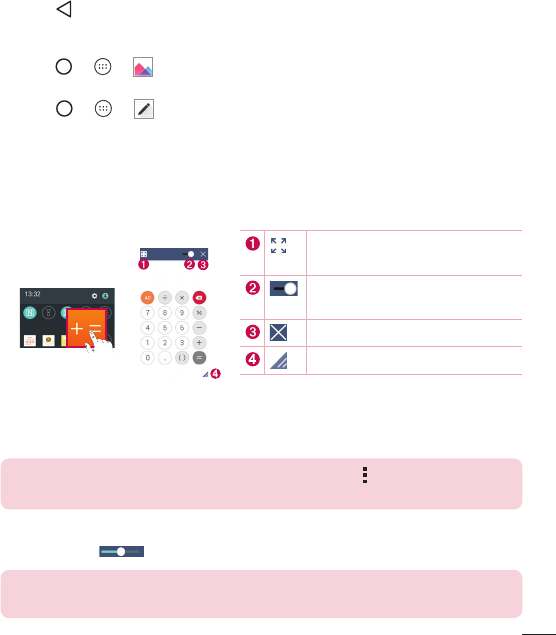
43
Special Features
Discard QuickMemos
• Tap .
View the Saved Memo
• Tap > > and select the QuickMemo+ album.
- OR -
Tap > > and select the desired memo.
QSlide
From any screen, use the Notification panel to easily access and use the Notepad,
Calendar, Calculator, and more with QSlide.
Tap to expand the window to full
window size.
Tap to adjust the window's
transparency.
Tap to close the QSlide window.
Drag to adjust the size.
1 Touch and slide the status bar downward > tap QSlide to view the available QSlide
apps.
TIP! While using applications that support QSlide, tap > QSlide.
The function is displayed as a small window on your screen.
2 You can use and tap the screen under the QSlide windows when the transparency
bar is not full .
NOTE
• QSlide can support up to two windows at the same time.
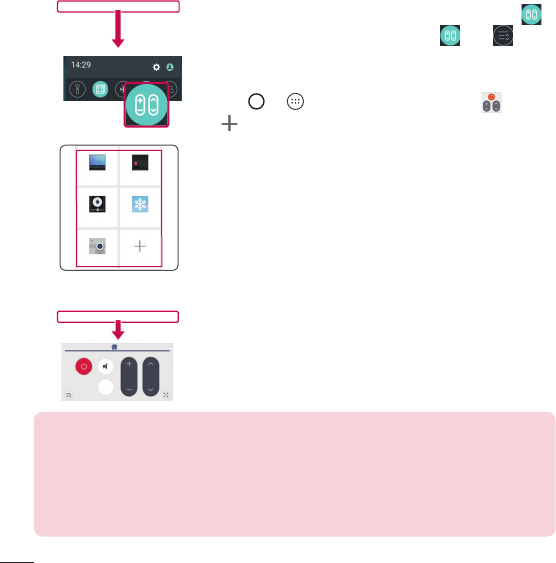
44 Special Features
QuickRemote
QuickRemote turns your phone into a Universal Remote for your home TV, set-top box
and audio system, and more.
Set up
1 Touch and slide the Status bar downward and tap
> ADD REMOTE. If you can not see , tap >
checkmark QuickRemote to enable.
- OR -
Tap > > Apps tab (if necessary) > > tap
.
2 Select the type and brand of the device, then follow the
on-screen instructions to configure the device.
Access your QuickRemote
3 Once you have completed the initial set up, you can
easily access the QuickRemote from the Notification
panel. Open the Notification panel and use the
QuickRemote functions.
NOTE
• The QuickRemote operates the same way as an ordinary remote control
infrared (IR) signals. Be careful not to cover the infrared sensor at the top
of the phone when you use the QuickRemote function. This function may
not be supported depending on the model, the manufacturer or service
company.
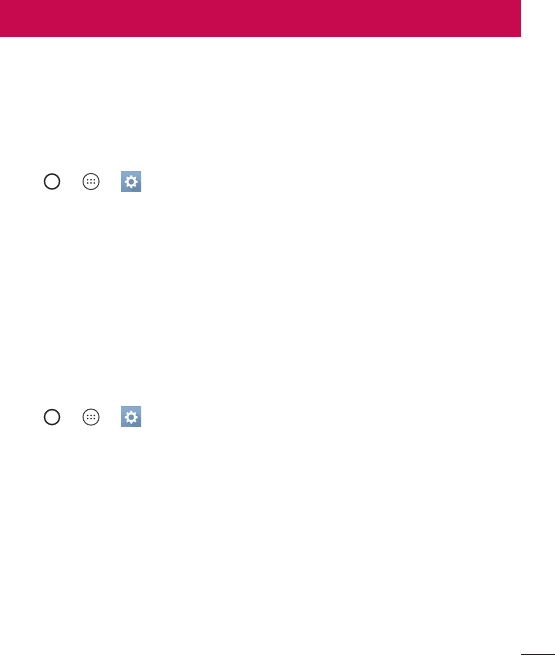
45
Google account setup
The first time you open a Google application on your phone, you will be required to sign
in with your existing Google account. If you do not have a Google account, you will be
prompted to create one.
Creating your Google account
1 Tap > > > General tab > Accounts & sync.
2 Tap ADD ACCOUNT > Google > Create a New Account.
3 Enter your first and last name, then tap NEXT.
4 Enter a username and tap NEXT. Your phone will communicate with Google servers
and check for username availability.
5 Enter your password and tap NEXT.
6 Follow the instructions and enter the required and optional information about the
account. Wait while the server creates your account.
Signing into your Google account
1 Tap > > > General tab > Accounts & sync.
2 Tap ADD ACCOUNT > Google.
3 Enter your email address and tap NEXT.
4 After signing in, you can use Gmail and take advantage of Google services on your
phone.
5 Once you have set up your Google account, your phone will automatically
synchronise with your Google account on the web (if a data connection is available).
Google account setup

46 Google account setup
After signing in, your phone will sync with your Google services, such as Gmail,
Contacts, and Google Calendar. You can also use Maps, download applications from
Play Store, back up your settings to Google servers, and take advantage of other Google
services on your phone.
IMPORTANT
• Some applications, such as Calendar, work only with the first Google Account
you add. If you plan to use more than one Google Account with your phone,
be sure to sign into the one you want to use with such applications first. When
you sign in, your contacts, Gmail messages, Calendar events, and other
information from these applications and services on the web are synchronised
with your phone. If you don't sign into a Google Account during setup, you will
be prompted to sign in or to create a Google Account the first time you start
an application that requires one, such as Gmail or Play Store.
• If you have an enterprise account through your company or other organization,
your IT department may have special instructions on how to sign into that
account.
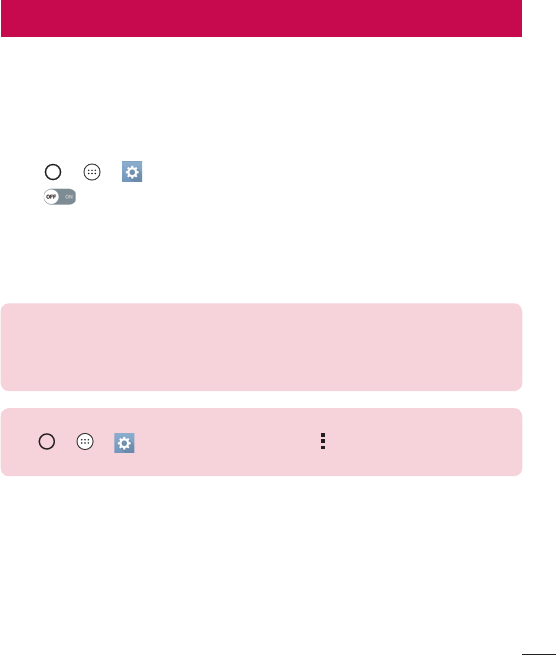
47
Connecting to Networks and Devices
Wi-Fi
You can use high-speed Internet access while within the coverage of the wireless
access point (AP).
Connecting to Wi-Fi networks
1 Tap > > > Networks tab > Wi-Fi.
2 Tap to turn Wi-Fi on and start scanning for available Wi-Fi networks.
3 Tap a network to connect to it.
• If the network is secured with a lock icon, you will need to enter a security key or
password.
4 The status bar displays icons that indicate Wi-Fi status.
NOTE
• If you are out of the Wi-Fi zone or have set Wi-Fi to Off, the device may
automatically connect to the Web using mobile data, which may incur data
charges.
TIP! How to obtain the MAC address
Tap > > > Networks tab > Wi-Fi > > Advanced Wi-Fi > MAC
address.
Connecting to Networks and Devices

48 Connecting to Networks and Devices
Bluetooth
Bluetooth is a short-range communications technology that allows you to connect
wirelessly to a number of Bluetooth devices, such as headsets and hands-free car kits,
and Bluetooth-enabled handhelds, computers, printers, and wireless devices.
NOTE
• LG is not responsible for the loss, interception or misuse of data sent or
received via the Bluetooth feature.
• Always make sure that you share and receive data with devices that are
trusted and properly secured.
• If there are obstacles between the devices, the operating distance may be
reduced.
• Some devices, especially those that are not tested or approved by Bluetooth
SIG, may be incompatible with your device.
Pairing your phone with another Bluetooth device
1 Tap > > > Networks tab > Bluetooth.
2 Tap to turn Bluetooth on and start scanning for available Bluetooth devices.
• If you want to detect the visible devices in range additionally, tap SEARCH.
3 Choose the device you want to pair with from the list. Once the paring is successful,
your phone connects to the other device.
NOTE
• Pairing between two Bluetooth devices is a one-time process. Once a
pairing has been created, the devices will continue to recognise their
partnership and exchange information.
TIP! Please consult documentation included with Bluetooth device for
information on pairing mode and passcode (typically 0 0 0 0 – four zeroes).
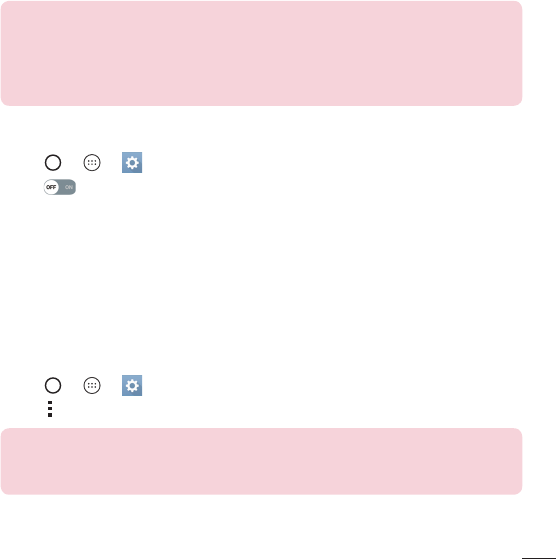
49
Connecting to Networks and Devices
Sending data via Bluetooth
1 Select a file or item such as a contact or media file.
2 Select the option for sending data via Bluetooth.
3 Search for and pair with a Bluetooth-enabled device.
NOTE
• Due to different specifications and features of other Bluetooth-compatible
devices, display and operations may be different, and functions such as
transfer or exchange may not be possible with all Bluetooth compatible
devices.
Receiving data via Bluetooth
1 Tap > > > Networks tab > Bluetooth.
2 Tap to turn Bluetooth on.
3 You will receive a request to accept a pairing attempt from the sending device. Be
sure to select Accept.
Wi-Fi Direct
Wi-Fi Direct provides a direct connection between Wi-Fi enabled devices without
requiring an access point.
Turning on Wi-Fi Direct
1 Tap > > > Networks tab > Wi-Fi.
2 Tap > Advanced Wi-Fi > Wi-Fi Direct.
NOTE
• When in this menu, your device is visible to other visible Wi-Fi Direct devices
nearby.
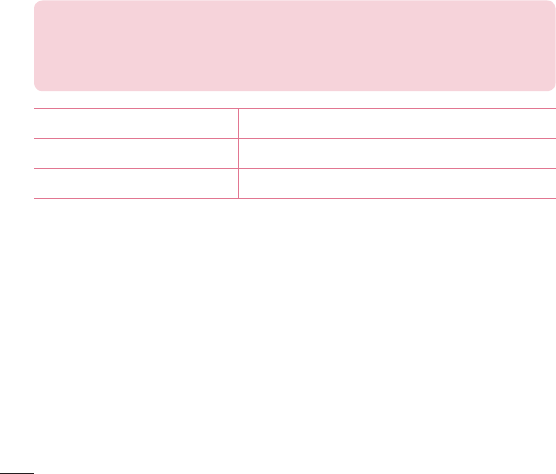
50 Connecting to Networks and Devices
Transferring data between a PC and the device
You can copy or move data between a PC and the device.
Transferring data
1 Connect your device to a PC using the USB cable that came with your phone.
2 Open the Notifications panel, tap the current connection type, and select Media
device (MTP).
3 A window will pop-up on your PC, allowing you to transfer the desired data.
NOTE
• The LG Android Platform Driver is required to be installed on your PC to be
able to detect the phone.
• Check the requirements for using Media device (MTP).
Items Requirement
OS Microsoft Windows XP SP3, Vista or higher
Window Media Player version Windows Media Player 10 or higher
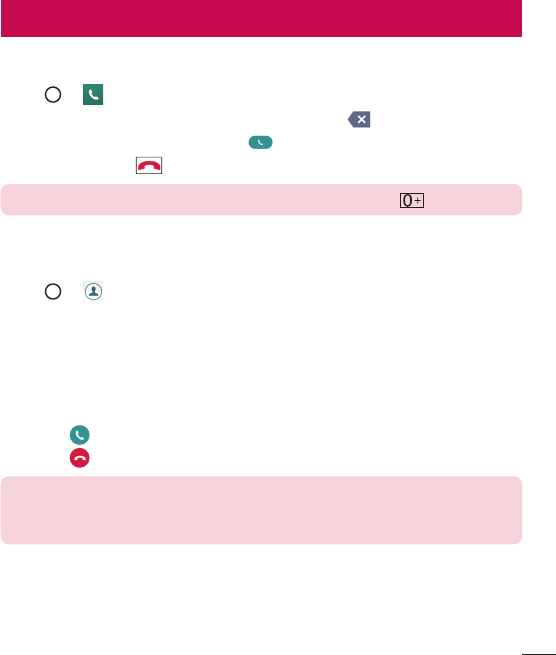
51
Calls
Making a call
1 Tap > to open the dialer.
2 Enter the number using the dialer. To delete a digit, tap .
3 After entering the desired number, tap to place the call.
4 To end the call, tap .
TIP! To enter "+" to make international calls, touch and hold .
Calling your contacts
1 Tap > to open your contacts.
2 Scroll through the contact list. You can also enter the contact's name in the Search
field or scroll along the alphabet letters on the right edge of the screen.
3 In the list that is displayed, tap the contact you want to call.
Answering and rejecting a call
• Swipe in any direction to answer the incoming call.
• Swipe in any direction to decline an incoming call.
NOTE
• Tap or swipe the Decline with message if you want to send a message to
the caller.
Calls
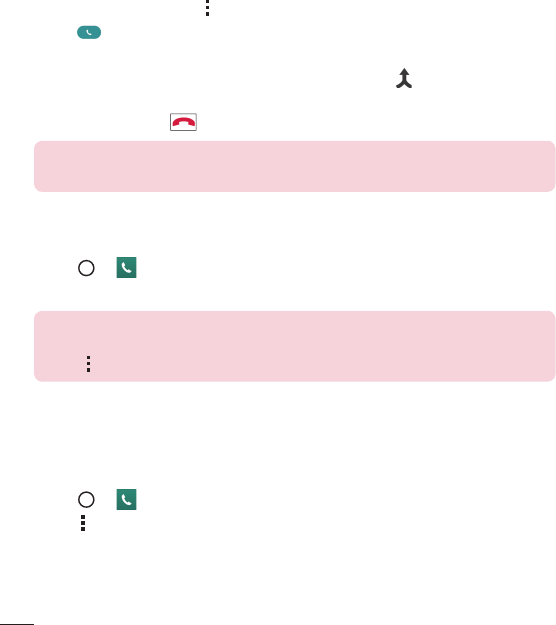
52 Calls
Making a second call
1 During your first call, tap > Add call and enter the number.
2 Tap to place the call.
3 Both calls are displayed on the call screen. Your initial call is locked and put on hold.
4 Tap the displayed number to toggle between calls. Or tap to start a conference
call.
5 To end all calls, tap .
NOTE
• You are charged for each call you make.
Viewing your call logs
1 Tap > > Call logs tab.
2 View a list of all dialed, received and missed calls.
TIP!
• Tap any call log entry to view the date, time and duration of the call.
• Tap > Delete all to delete all of the recorded items.
Call settings
You can configure phone call settings, such as call forwarding, as well as other special
features offered by your carrier.
1 Tap > to open the dialer.
2 Tap > Call settings and configure the desired options.
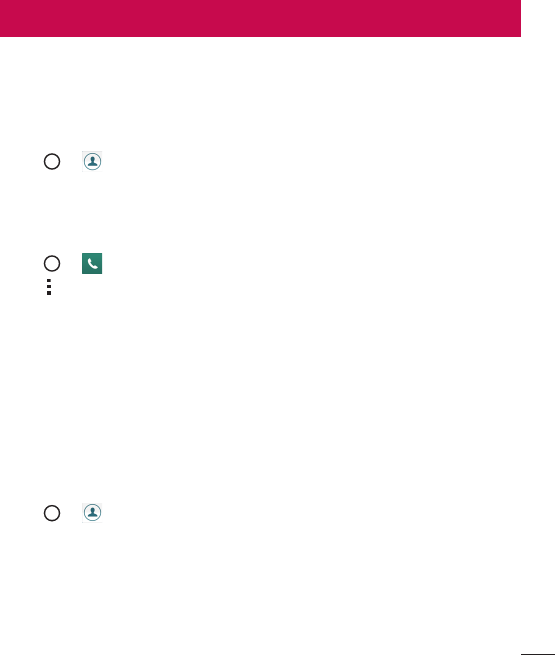
53
Contacts
You can add contacts on your phone and synchronise them with the contacts in your
Google Account or other accounts that support syncing contacts.
Searching for a contact
1 Tap > to open your contacts.
2 Tap Search contacts and enter the contact name using the keyboard.
Adding a new contact
1 Tap > and enter the new contact's number.
2 Tap > Add to Contacts > New contact.
3 If you want to add a picture to the new contact, tap the image icon.
Choose Take photo or Select from Gallery.
4 Enter the desired information for the contact.
5 Tap SAVE.
Favourites contacts
You can classify frequently called contacts as favourites.
Adding a contact to your favourites
1 Tap > to open your contacts.
2 Tap a contact to view its details.
3 Tap the star at the top right of the screen. The star turns yellow.
Contacts

54 Contacts
Removing a contact from your favourites list
1 Tap > > Favourites tab.
2 Choose a contact to view its details.
3 Tap the yellow star at the top right of the screen. The star turns a dark colour and
the contact is removed from your favourites.
Creating a group
1 Tap > > Groups tab.
2 Tap > New group.
3 Enter a name for the new group. You can also set a distinct ringtone for the newly
created group.
4 Tap Add members to add contacts to the group and tap ADD.
5 Tap SAVE to save the group.
NOTE
• If you delete a group, the contacts assigned to that group will not be lost.
They will remain in your contact list.
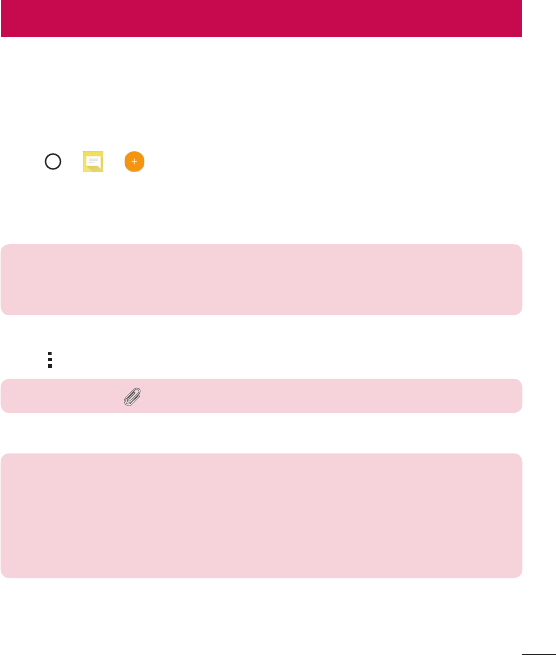
55
Messaging
Your phone combines text and multimedia messaging into one intuitive, easy to use
menu.
Sending a message
1 Tap > > .
2 Enter a contact name or contact number into the To field. As you enter the contact
name, matching contacts appear. You can tap a suggested recipient and add more
than one contact.
NOTE
• You may be charged for each text message you send. Please consult with
your service provider.
3 Tap the text field and start entering your message.
4 Tap to open the options menu. Choose from any of the available options.
TIP! You can tap to attach the file that you want to share with message.
5 Tap Send to send your message.
TIP!
• The 160-character limit may vary from country to country depending on how
the text message is coded and the language used in the message.
• If an image, video, or audio file is added to a text message, it will be
automatically converted into a multimedia message and you will be charged
accordingly.
Messaging

56 Messaging
NOTE
• When you get a text message during a call, there will be an audible
notification.
Conversation view
Messages exchanged with another party are displayed in chronological order so that
you can conveniently see and find your conversations.
Changing your messaging settings
Your phone's messaging settings are predefined to allow you to send messages
immediately. You can change the settings based on your preferences.
• Tap > > > Settings.
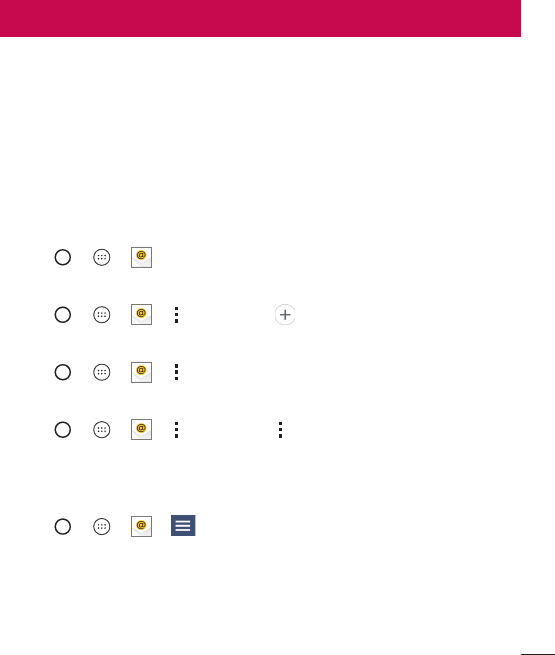
57
E-mail
You can use the Email application to read email from providers other than Gmail.
TheEmail application supports the following account types: POP3, IMAP and Microsoft
Exchange (for Enterprise users).
Managing email accounts
To open the Email application
The first time you open the Email application, a setup wizard opens to help you add an
email account.
• Tap > > .
Adding another email account:
• Tap > > > > Settings > .
Changing an email general settings:
• Tap > > > > Settings > General settings.
Deleting an email account:
• Tap > > > > Settings > > Remove account > Select the
account to delete > REMOVE > YES.
Working with account folders
• Tap > > > > Show all folders.
Each account has Inbox, Outbox, Sent and Drafts folders. Depending on the features
supported by your account's service provider, you may have additional folders.
E-mail
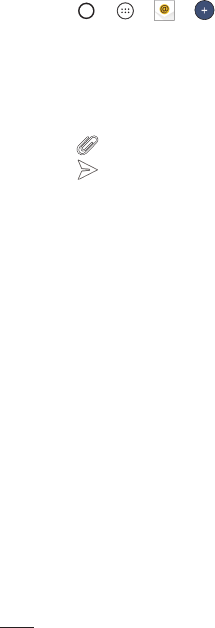
58 E-mail
Composing and sending email
1 Tap > > > to create a new email.
2 Enter an address for the message's intended recipient. As you enter text, matching
addresses will be offered from your contacts. Separate multiple addresses with
semicolons.
3 Tap the Cc/Bcc field to copy or blind copy to other contacts/email addresses.
4 Tap the text field and enter your message.
5 Tap to attach the file you want to send with your message.
6 Tap to send the message.
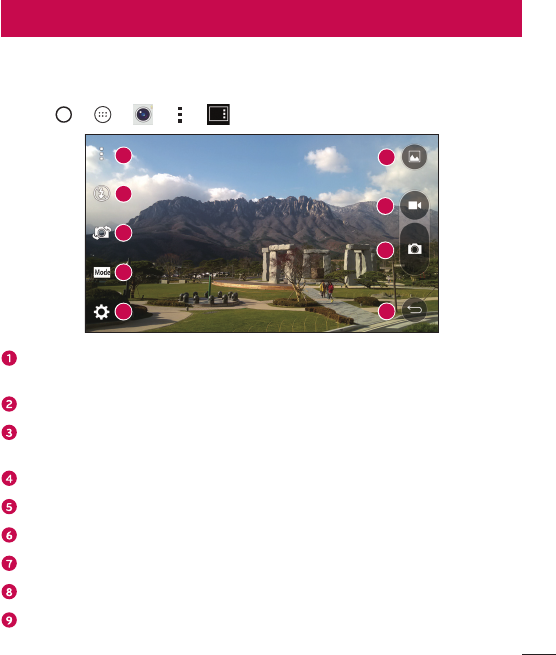
59
Camera and Video
Camera options on the viewfinder
You can use the camera or camcorder to take and share pictures and videos.
• Tap > > > > .
16
9
2
7
8
3
4
5
Hide/Display Options – Tap to hide/display the camera options on the viewfinder.
Choose from Simple, Auto or Manual.
Flash – Allows you to manage the camera's flash.
Swap camera – Tap to swap between the rear camera lens and the front camera
lens.
Shot mode – Allows you to select the shot mode for the picture.
Settings – Tap this icon to open the camera settings menu.
Gallery – Tap to view the last photo or video you recorded.
Record – Tap to start recording.
Capture – Tap to take a photo.
Back Button – Tap to exit the camera.
Camera and Video
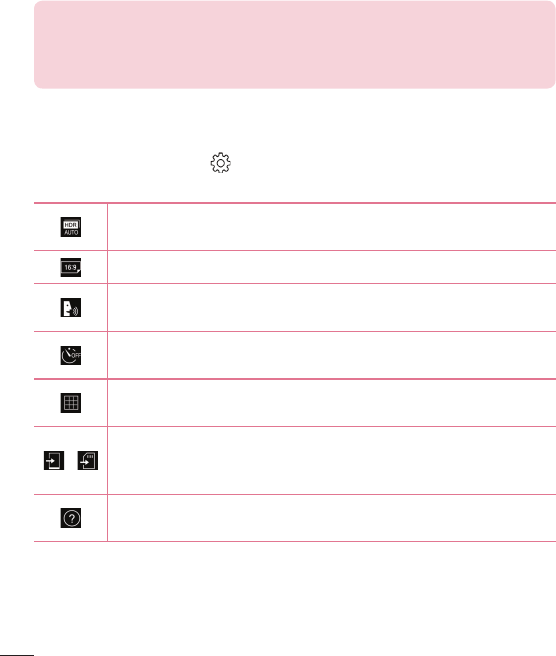
60 Camera and Video
NOTE
• Be sure to clean the protective lens cover with a microfiber cloth before
taking pictures. A lens cover with smudges from fingers can cause blurry
pictures with a "halo" effect.
Using the advanced settings
In the camera viewfinder, tap to show the advanced options. Tap each icon to
adjust the following camera settings.
Combines photos taken at multiple exposures into one optimal photo to
get a better photo in difficult lighting situations.
Set the size of your picture and video.
Allows you to take pictures with voice commands. When on, you just say
"Cheese", "Smile", "LG", etc. to take a picture.
Set your camera's timer. This is ideal if you want to be a part of the
picture or video.
Allows you to take better pictures and record better videos by displaying
a grid line for help with alignment.
/
Set the storage location for your pictures and videos. Choose from IN
(internal memory) and SD (memory card). This menu appears only when
the SD card is inserted.
Allows you to learn how a function works. This icon will provide you with
a help guide.
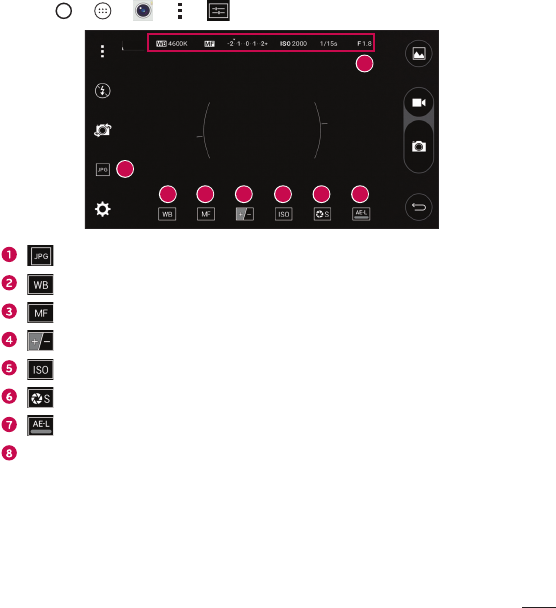
61
Camera and Video
Manual mode on the viewfinder
You can control every detail option manually.
• Tap > > > > .
1
62 7
8
3 4 5
– Tap to select a file format between the JPEG and the DNG.
– Tap to improve colour quality in various lighting conditions.
– Tap to use the manual focus mode.
– Tap to adjust the brightness.
– Tap to adjust the ISO.
– Tap to adjust the shutter speed.
– Tap to use the auto expose lock.
Display the manual status information.
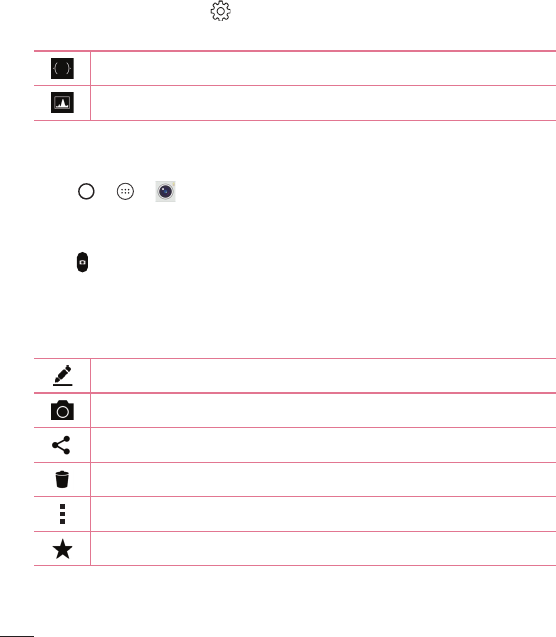
62 Camera and Video
Using the advanced settings for the manual mode
In the camera viewfinder, tap to show the advanced options. Tap each icon to
adjust the following camera settings.
Tap to display a incline or a grid line for help with alignment.
Tap to display a histogram.
Taking a photo
1 Tap > > .
2 Frame your subject on the screen.
3 A square around the subject indicates that the camera has focused.
4 Tap to take a photo. Your picture will be automatically saved to the Gallery.
Once you have taken a photo
Tap the image thumbnail on the screen to view the last photo you took.
Tap to edit the photo.
Tap to take another photo immediately.
Tap to open the available sharing options.
Tap to delete the photo.
Tap to access additional options.
Tap to add the photo to your favourites.
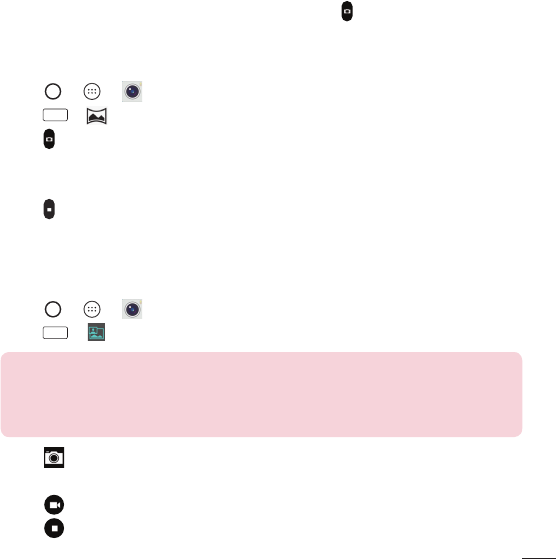
63
Camera and Video
Multi-point Auto Focus
When you take a picture, the Multi-point Auto Focus (AF) function operates
automatically and will allow you to see a clear image.
Burst shot
Allows you to take multiple shots quickly. Touch and hold .
Panorama mode
Allows you to take a panoramic picture.
1 Tap > > .
2 Tap
Mode
> .
3 Tap to start taking the panoramic picture.
4 Pan your phone slowly in one direction.
5 Make sure that the focus area aligns with the blue guideline while taking the photo.
6 Tap to stop taking the panoramic picture.
Dual mode
The Dual feature allows you to take a picture or record a video with the front and rear
cameras at the same time.
1 Tap > > .
2 Tap
Mode
> .
NOTE
• Drag the small screen to move it to your desired location. Touch and hold
the small screen to resize it. Tap on the small screen to alternate between
the two cameras.
3 Tap to take a picture.
- OR -
Tap to record video.
4 Tap to stop dual recording.
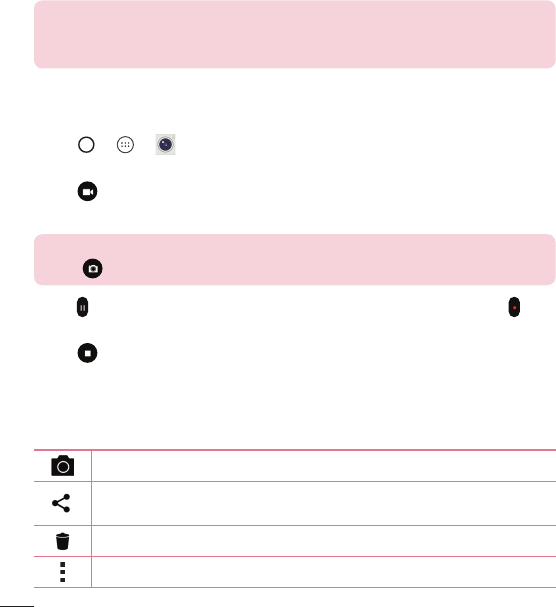
64 Camera and Video
8X Zooming
When using the rear camera lens, you can zoom in or out to 8x.
NOTE
• Use a steady hand. This feature does not work with some functions. Objects
may be overlapped when taking a picture of fast-moving subjects.
Recording a video
1 Tap > > .
2 Frame your subject on the screen.
3 Tap to start recording the video.
4 The length of the recording is displayed on the top of the screen.
NOTE
• Tap to take pictures while recording video.
5 Tap to pause recording video. You can resume recording again by tapping .
- OR -
Tap to stop recording. Your video will be automatically saved to the Gallery.
After recording a video
Tap the video thumbnail on the screen to view the last video you recorded.
Tap to record another video immediately.
Tap to open the available sharing options (such as Messaging or Bluetooth)
to share.
Tap to delete the video.
Tap to access additional options.
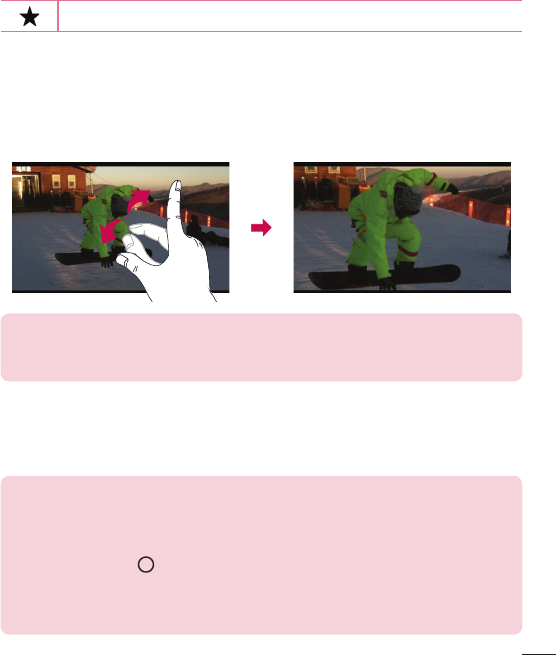
65
Camera and Video
Tap to add the video to your favourites.
Live Zoom
Live Zoom allows you to zoom in or out on a portion of a video that is being played to
make the desired section appear larger or smaller.
When viewing a video, use your index finger and thumb in a pinching or spreading
motion to zoom in or out.
NOTE
• Do not press too hard; the touch screen is sensitive enough to pick up a
light, but firm touch.
Dual Play
Dual Play (wired or wireless connection to two displays) can be run on a different
screen.
NOTE
• Connect two devices using a wired (Slimport-HDMI) cable or wirelessly
(Miracast). The connectable device can be a TV or a monitor supported
by an HDMI cable or Miracast. The Gallery and Video apps are supported
on Dual Play. Tap once when two displays are a different status (i.e.
the monitor is playing a video and your phone’s video app is displaying an
empty screen), then Dual Play will start. Not all videos are supported by Dual
Play. Dual Play operates at 1280X720 or higher display resolution.

66 Camera and Video
Gallery
The Gallery application presents the pictures and videos in your storage, including those
you've taken with the Camera application and those you downloaded from the web or
other locations.
1 Tap > > to view the images stored in the storage.
2 Tap an album to open it and view its contents. (The pictures and videos in the album
are displayed in chronological order.)
3 Tap a picture in an album to view it.
NOTE
• Depending on the software installed, some file formats may not be
supported.
• Some files may not play properly due to their encoding.
Viewing pictures
The Gallery displays your pictures in folders. When an application, such as E-mail, saves
a picture, the download folder is automatically created to contain the picture. Likewise,
capturing a screenshot automatically creates the Screenshots folder.
Pictures are displayed by the date they were created. Select a picture to view it full
screen. Scroll left or right to view the next or previous image.
Timeline view
The Gallery automatically sorts and displays a lot of photos in chronological order to see
at a glance.
1 Tap > > .
2 Tap > Timeline.
3 Select from Year, Month and Day.

67
Camera and Video
Memories view
The Gallery automatically organises and displays the memories albums depending on
the region and time information of saved photos.
1 Tap > > .
2 Tap > Memories.
3 Select memories albums.
NOTE
• This feature is a location based service. Take photos and videos with their
locations.
Zooming in and out
Use one of the following methods to zoom in on an image:
• Double-tap anywhere to zoom in.
• Spread two fingers apart on any place in the picture zoom in. Pinch in or double-
tap the image to zoom out.
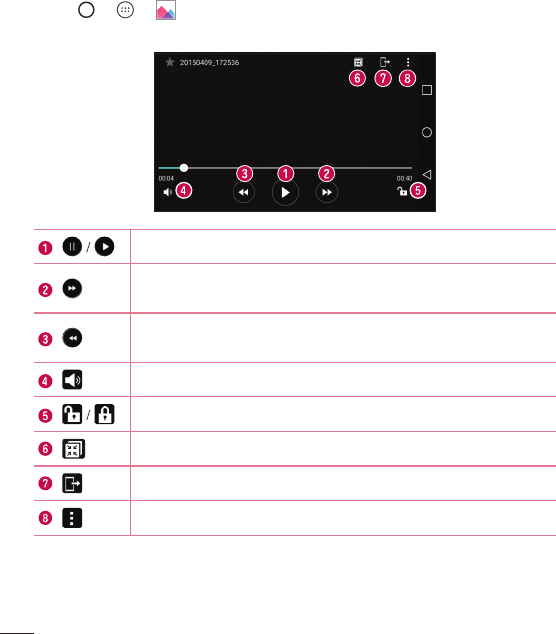
68 Camera and Video
Video options
1 Tap > > .
2 Select the video you want to watch.
Tap to pause/resume video playback.
Touch and hold to fast-forward in 3 second increments.
Tap to fast-forward 10 seconds.
Touch and hold to rewind in 3 second increments.
Tap to rewind 10 seconds.
Tap to adjust the video volume.
Tap to lock/unlock the screen.
Tap to use QSlide for the Video app.
Tap to share your video using the SmartShare function.
Tap to access additional options.

69
Camera and Video
NOTE
• While playing a video, slide the right side of the screen up or down to adjust
the sound.
• While playing a video, slide the left side of the screen up or down to adjust
the brightness.
• While playing a video, slide your finger from left to right (or vice versa) to
fast-forward and rewind.
Editing photos
While viewing a photo, tap .
Deleting photos/videos
Use one of the following methods:
• While in a folder, tap , select the photos/videos and then tap DELETE.
• While viewing a photo, tap .
Setting wallpaper
While viewing a photo, tap > Set image as to set the image as wallpaper or assign
it to a contact.
NOTE
• Depending on the software installed, some file formats may not be
supported.
• If the file size exceeds the available memory, an error can occur when you
open files.
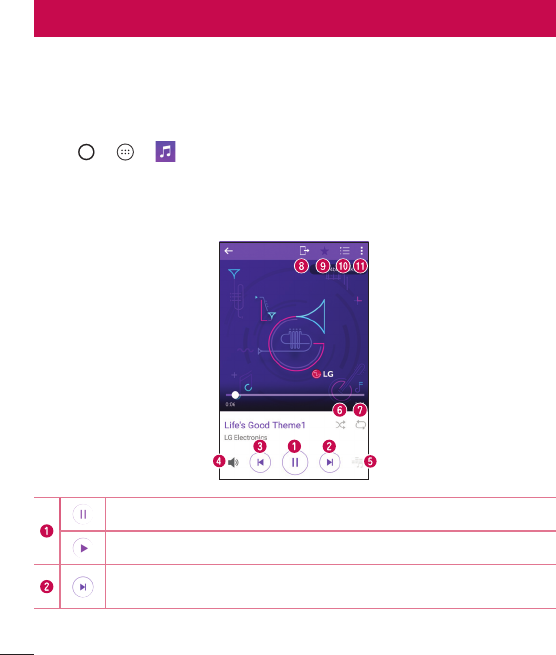
70 Multimedia
Music
Your phone has a music player that lets you play all your favourite tracks.
Playing a song
1 Tap > > .
2 Tap the Songs tab.
3 Select the song you want to play.
4 The following options are available.
Tap to pause playback.
Tap to resume playback.
Tap to skip to the next track in the album, playlist or shuffle list. Touch and
hold to fast-forward.
Multimedia
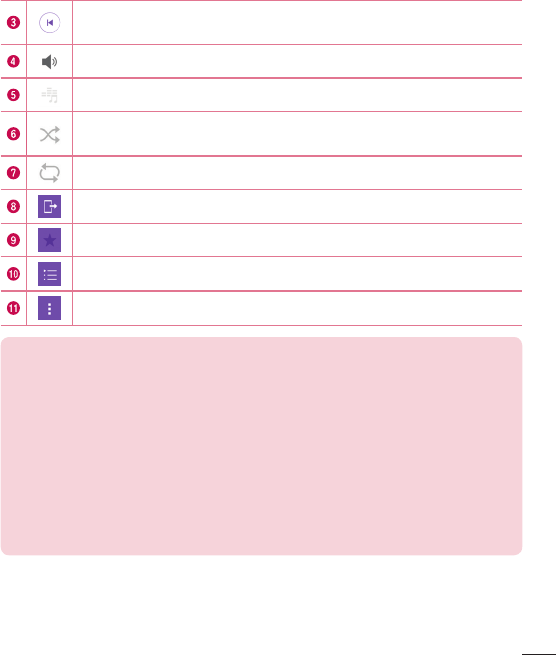
71
Multimedia
Tap to restart the current track or skip to the previous track in the album,
playlist or shuffle list. Touch and hold to rewind.
Tap to adjust the volume.
Tap to set audio effects.
Tap to play the current playlist in shuffle mode (tracks are played in
random order).
Tap to toggle through repeat all songs, repeat current song and repeat off.
Tap to share your music using the SmartShare function.
Tap to add the song to your favourites.
Tap to open the current playlist.
Tap to access additional options.
NOTE
• Depending on the software installed, some file formats may not be
supported.
• If the file size exceeds the available memory, an error can occur when you
open files.
• Music file copyrights may be protected by international treaties and national
copyright laws. Therefore, it may be necessary to obtain permission or
a licence to reproduce or copy music. In some countries, national laws
prohibit private copying of copyrighted material. Before downloading or
copying the file, please check the national laws of the relevant country
concerning the use of such material.
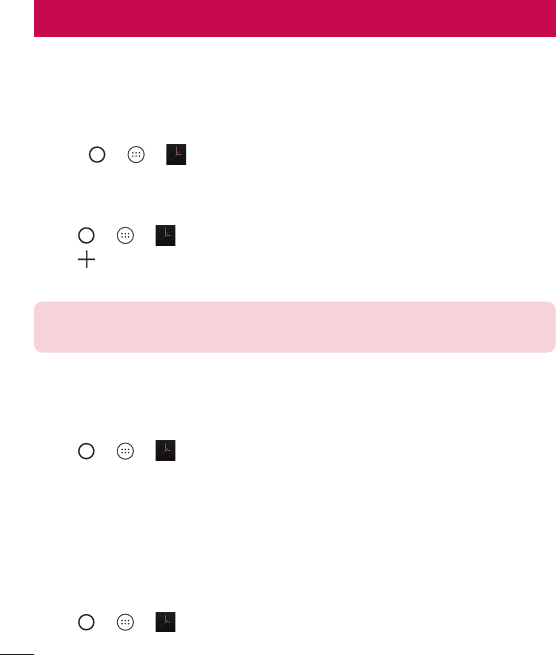
72 Utilities
Clock
The Clock app gives you access to the Alarms, Timer, World clock and Stopwatch
functions. Access these functions by tapping the tabs across the top of the screen or
swiping horizontally across the screen.
• Tap > > .
Alarms
The Alarms tab allows you to set alarms.
1 Tap > > > Alarms tab.
2 Tap to add a new alarm.
3 Adjust the settings as necessary and tap Save.
NOTE
• You can also tap an existing alarm to edit it.
Timer
The Timer tab can alert you with an audible signal when a set amount of time has
passed.
1 Tap > > > Timer tab.
2 Set the desired time on the timer.
3 Tap Start to start the timer.
4 Tap Stop to stop the timer.
World clock
The World clock tab allows you to easily check the current time in other cities around
the world.
1 Tap > > > World clock tab.
Utilities
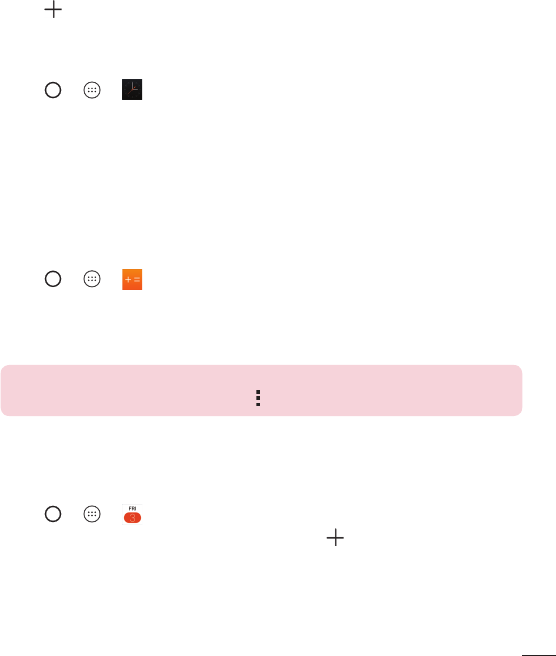
73
Utilities
2 Tap and select the desired city.
Stopwatch
The Stopwatch tab allows you to use your phone as a stopwatch.
1 Tap > > > Stopwatch tab.
2 Tap Start to initiate the stopwatch.
• Tap Lap to record lap times.
3 Tap Stop to stop stopwatch.
Calculator
The Calculator app allows you to perform mathematical calculations using a standard or
scientific calculator.
1 Tap > > .
2 Tap the number buttons to enter numbers.
3 For simple calculations, tap the function you want to perform (+, –, x or ÷) followed
by =.
NOTE
• For more complex calculations, tap .
Calendar
The Calendar app allows you to track your schedule of events.
1 Tap > > .
2 Tap the date you want to add an event to. Then tap .
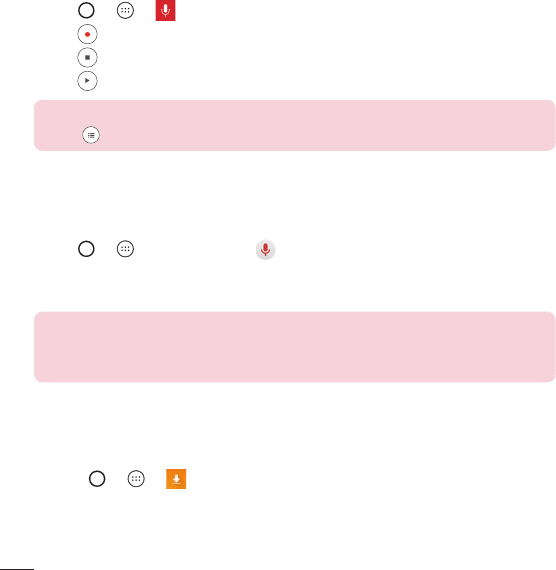
74 Utilities
Voice Recorder
The Voice Recorder app records audible files for you to use in a variety of ways.
Recording a sound or voice
1 Tap > > .
2 Tap to begin recording.
3 Tap to end the recording.
4 Tap to listen to the recording.
NOTE
• Tap to access your recordings. You can listen to your saved recordings.
Voice Search
Use this application to search webpages using voice.
1 Tap > > Google folder > .
2 Say a keyword or phrase when Listening... appears on the screen. Select one of the
suggested keywords that appear.
NOTE
• This application may not be available depending on the region or service
provider.
Downloads
Use this application to see what files have been downloaded through the applications.
• Tap > > .

75
Utilities
NOTE
• This application may not be available depending on the region or service
provider.
FM radio
Your phone has a built-in FM radio so you can tune in to your favourite stations and
listen on the go.
• Tap > > .
TIP! You must plug in your earphones in order to use them as an antenna.
NOTE
• This application may not be available depending on the region or service
provider.
LG Health
The LG Health helps you manage your health and maintain good exercise habits by
tracking logs and competing with people.
1 Tap > > .
2 Read and agree to the terms and conditions.
3 On the Profile and goal page, enter your profile information and tap Save.
4 Use the options below to begin tracking activity.
NOTE
• This feature is provided for user convenience. Please use for reference only.
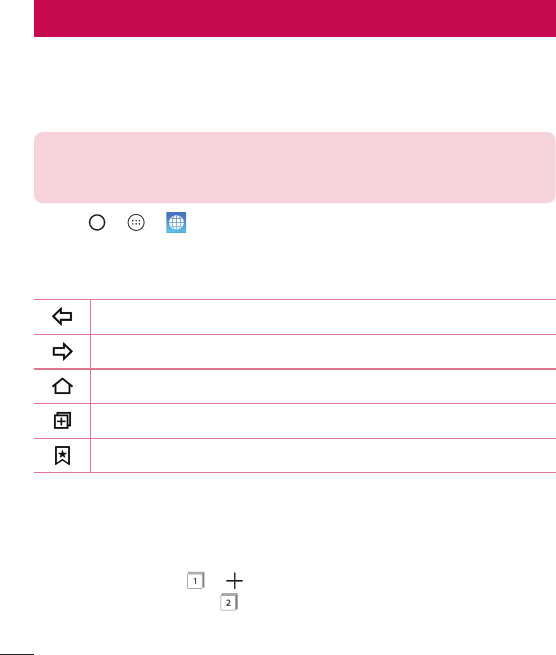
76 Web Browser
Internet
The internet gives you a fast, full colour world of games, music, news, sports,
entertainment, and much more, right on your mobile phone.
NOTE
• Additional charges apply when connecting to these services and
downloading content. Check data charges with your network provider.
• Tap > > .
Using the Web toolbar
Scroll towards the top of the webpage to access the browser toolbar.
Tap to go back one page.
Tap to go forward one page.
Tap to go to the Home page.
Tap to open a new window.
Tap to access your bookmarks.
Viewing webpages
Tap the address field, enter the web address and tap Go on the keyboard.
Opening a page
To go to a new page, tap > .
To go to another webpage, tap , scroll up or down, and tap the page to select it.
Web Browser
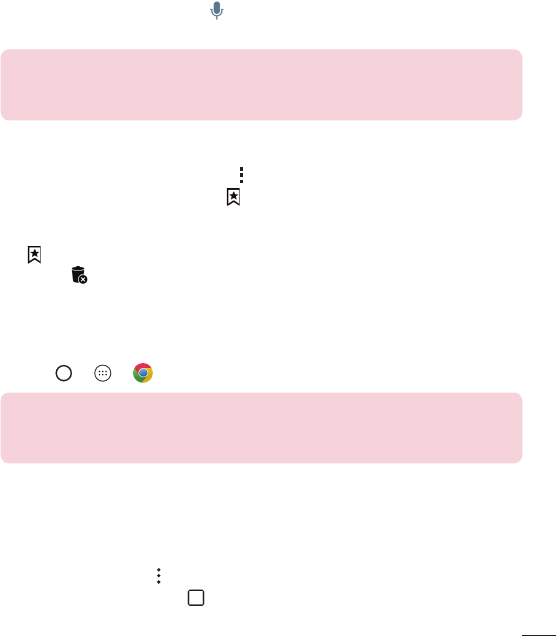
77
Web Browser
Searching the web by voice
Tap the address field and then tap . When prompted, say a keyword and select one
of the suggested keywords that appear.
NOTE
• This feature may not be available depending on the region or service
provider.
Bookmarks
To bookmark the current webpage, tap > Add to bookmarks > OK.
To open a bookmarked webpage, tap and select the desired bookmark.
History
Tap > History tab to open a list of recently visited webpages. To clear all of your
history, tap > Yes.
Chrome
Use Chrome to search for information and browse webpages.
• Tap > > .
NOTE
• This application may not be available depending on your region and service
provider.
Viewing webpages
Tap the address field, and then enter a web address or search criteria.
Opening a page
To open a new page, tab > New tab.
To go to another webpage, tap and tap the page to select it.
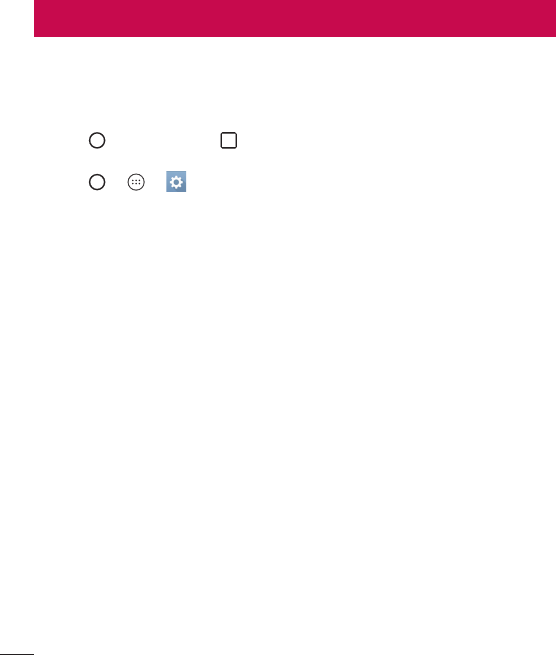
78 Settings
The Settings application contains most of the tools for customizing and configuring your
phone. All of the settings in the Settings application are described in this section.
To open the Settings application
• Tap > touch and hold > System settings.
- OR -
• Tap > > .
Networks
< WIRELESS NETWORKS >
Wi-Fi
Turns on Wi-Fi to connect to available Wi-Fi networks.
Bluetooth
Turns the Bluetooth wireless feature on or off to use Bluetooth.
Mobile data
Displays the data usage and mobile data usage limit.
Call
This menu allows you to configure various call settings.
• Voicemail – Allows you to select your carrier’s voicemail service.
• Fixed dialing numbers – Allows you to manage and compile a list of numbers
that can be called from your phone. You need your PIN2, which is available from
your operator. If activated, only numbers in the fixed dial list can be called from
your phone.
• Incoming voice call pop-up – Displays a pop-up for an incoming call when an
app is in use.
• Call reject – Allows you to set the call decline function.
Settings

79
Settings
• Decline with message – When you want to decline a call, you can send a quick
message using this function. This is useful if you need to decline a call during a
meeting.
• Call forwarding – Allows you to choose when to forward calls.
• Auto answer – Sets the time before a connected hands-free device automatically
answers an incoming call.
• Connection vibration – Vibrates your phone when the other party answers the
call.
• Noise suppression – Suppresses background noise on your device during a call.
• Voice clarity – Enhances voice quality in noisy environments so you can hear
more clearly.
• Save unknown numbers – Allows you to add unknown numbers to contacts after
a call.
• Power key ends call – Allows you to use the Power key to end calls.
• Answer an incoming call – Checkmark to enable you to bring the device to your
ear to automatically answer the incoming call.
• Silence incoming calls – Checkmark to allow you to flip the device to silence
incoming calls.
• Call barring – Locks incoming, outgoing or international calls.
• Call duration – Allows you to view the call duration for various types of calls.
• Additional settings – Allows you to change the following settings.
< CONNECTIVITY >
Share & connect
• NFC – Your phone is an NFC-enabled cell mobile phone. NFC (Near Field
Communication) is a wireless connectivity technology that enables two-way
communication between electronic devices. It operates over a distance of a few
centimetres. You can share your content with an NFC tag or another NFC support
device by simply tapping it with your device. If you tap an NFC tag with your
device, it displays the tag content on your device.
• Android Beam – When this feature is turned on, you can transfer app content to
another NFC-capable device by holding the devices close together.

80 Settings
Just bring the device together (typically back to back) and then tap your screen.
The app determines what gets beamed.
• SmartShare Beam – Allows you to receive multimedia content via LG phones and
tablets.
• Media server – Share media content with nearby DLNA-compatible devices.
• Miracast – Allows you to wirelessly mirror the phone screen and sound onto a
Miracast dongle or TV.
• LG Bridge – Allows you to connect to a computer to manage your phone.
• Printing – Allows you to print the content of certain screens (such as web pages
displayed in Chrome) to a printer connected to the same Wi-Fi network as your
Android device.
Tethering
• USB tethering – Allows you to share the internet connection with your computer
via a USB cable.
• Wi-Fi hotspot – Allows you to create a hotspot and share your connection. Please
consult "Sharing your phone’s data connection" for more information.
• Bluetooth tethering – Allows you to connect to other devices via Bluetooth.
• Help – Displays Help information about USB tethering, Wi-Fi hotspot, and Bluetooth
tethering.
More
• Airplane mode – Airplane Mode (flight mode) allows you to use many of your
phone's features, such as games, and music, when you are in an area where
making or receiving calls or data use is prohibited. When you set your phone to
Airplane Mode, it cannot send or receive any calls or access online data.
• Mobile networks – This menu allows you to configure various mobile network
settings.
• VPN – From your phone, you can add, set up, and manage virtual private networks
(VPNs) that allow you to connect and access resources inside a secured local
network, such as your corporate network.

81
Settings
Sound & notification
< BASIC >
Sound profile
Allows you to set your phone's sound profile. Choose from Sound, Vibrate only.
< SOUND >
Volume
Adjust the phone’s volume settings to suit your needs and environment.
Ringtone
Allows you to set the ringtones for calls. You can also add a ringtone by tapping in
the upper-right corner of the screen.
Ringtone ID
Allows you to compose ringtones based on phone number of incoming call.
< VIBRATION >
Vibration strength
Allows you to set the vibration strength for calls, notifications and touch feedback.
Sound with vibration
Checkmark to set the phone to vibrate in addition to the ringtone when you receive
calls.
Vibration type
Allows you to choose the type of vibration.
< NOTIFICATIONS >
Interruptions
Allows you to set a schedule when to prevent interruptions from notifications. You can
set to allow certain features to interrupt when Priority only is set.
Lock screen
Allows you to choose if you want to show or hide notifications on the lock screen.

82 Settings
Apps
Allows you to prevent apps from displaying notifications or set apps to show
notifications with priority when Do not disturb is set to Priority only.
Notification LED
Tap the switch to toggle it On or Off. On activates the LED light for the notifications you
select, in the colour you set for each.
< ADVANCED SETTINGS >
More
• Notification sound – Allows you to set the notification sound. You can also add a
notification sound by tapping in the upper-right corner of the screen.
• Vibrate on tap – Checkmark to vibrate when tapping the Home touch buttons and
during other UI interactions.
• Sound effects – Tap to set the dial pad touch tones, touch sounds and screen
lock sound.
• Message/call voice notifications – Tap the Message/call voice notifications
switch to toggle it On or Off. On allows your device to read out incoming calls and
message events automatically.
Display
< HOME & LOCK >
Home screen
• Select Home – Set Home or EasyHome as the default home.
• Smart Bulletin – Tap the Smart Bulletin switch to toggle it On or Off. Activating
this feature adds an additional Home screen showing customised information.
• Theme – Sets the screen theme for your device. You can download new themes
from LG SmartWorld.
• Wallpaper – Sets the wallpaper to use on your Home screen.
• Screen swipe effect – Choose the desired type of effect to display when you
swipe from one Home screen canvas to the next.

83
Settings
• Allow Home screen looping – Displays the first screen after the last screen when
scrolling the Home screen.
• Help – Displays help information for the Home screen.
Lock screen
• Select screen lock – Set a screen lock type to secure your phone. Opens a set of
screens that guide you through drawing a screen unlock pattern.
If you enabled a Pattern lock type when you turn on your phone or wake up the
screen, you are asked to draw your unlock pattern to unlock the screen.
• Smart Lock – Sets to keep your phone unlocked with trusted device or a place.
• Screen swipe effect – Sets the screen swipe effect options.
NOTE
• This setting name may be Pattern effect if the Screen lock is set to Pattern.
• Wallpaper – Allows you to set your Lock screen wallpaper.
• Shortcuts – Allows you to choose the shortcuts available on the lock screen.
• Weather animation – Checkmark to show weather animation on the lock screen
for the current location.
• Contact info for lost phone – Allows you to display the owner information on the
lock screen in case the phone is lost.
• Lock timer – Sets the amount of time before the screen automatically locks after
the screen has timed out.
• Power button instantly locks – Checkmark to instantly lock the screen when the
Power/Lock Button is pressed. This setting overrides the Security lock timer setting.
Home touch buttons
Set the Home touch buttons displayed at the bottom of all screens. Set which keys are
displayed, their position on the bar and what they look like.

84 Settings
< FONT >
Font type
Select the desired font type.
Font size
Select the desired font size.
< BASIC SETTINGS >
Brightness
Adjust the screen brightness by using the slider.
Auto-rotate screen
Set to switch orientation automatically when you rotate the phone.
Screen timeout
Set the time delay before the screen automatically turns off.
< ADVANCED SETTINGS >
More
• Daydream - Select the screen saver to display when the phone is sleeping while
docked and/or charging.
• Motion sensor calibration – Allows you to improve the accuracy of the tilt and
speed of the sensor.
General
< PERSONAL >
Language & input
Select the language for the text on your phone and for configuring the on-screen
keyboard, including words that you've added to its dictionary.
• Language – Choose a language to use on your phone.
• Default – Allows you to select the default keyboard type.
• LG Keyboard – Tap the Settings icon to change the LG Keyboard settings.
• Google voice typing – Checkmark to select Google voice typing to enter data. Tap
the Settings icon to change the Google voice settings.

85
Settings
• Voice Search – Tap to configure the Voice Search settings.
• Text-to-speech output – Tap to set the preferred engine or general settings for
text-to-speech output.
• Pointer speed – Adjust the pointer speed.
Location
Turn on location service, your phone determines your approximate location using Wi-Fi
and mobile networks. When you select this option, you're asked whether you consent to
allowing Google to use your location when providing these services.
• Mode – Sets the how your current location information is determined.
• My place – Locate your home for Smart settings.
• Camera – Checkmark to tag photos or videos with their locations.
• Google Location Reporting – Allows you to choose your location information
settings as accessed by Google and its products.
Accounts & sync
Use the Accounts & sync settings menu to add, remove, and manage your Google and
other supported accounts. You also use these settings to control how and whether
all applications send, receive, and sync data on their own schedules and whether all
applications can synchronise user data automatically.
Gmail™, Calendar, and other applications may also have their own settings to control
how they synchronise data; see the sections on those applications for details. Tap ADD
ACCOUNT to add new account.
Cloud
Allows you to add a cloud account to quickly and easily use a cloud service.
Users
Checkmark to add users when phone locked.
Add user to share the phone with other people. Each user can have their own apps and
content in their own space. Anyone using the phone can change settings like Wi-Fi and
accept app updates that will affect everyone. Initial setup is required for new users to
use phone.

86 Settings
Accessibility
Use the Accessibility settings to configure accessibility plug-ins you have installed on
your phone.
• Vision
- TalkBack – Allows you to set up the TalkBack function which assists people with
impaired vision by providing verbal feedback.
- Message/call voice notifications – Tap to toggle it On or Off. On allows
you to hear automatic spoken alerts for incoming calls and messages.
- Screen shade – Checkmark to set the screen to a darker contrast.
- Font size – Sets the font size.
- Touch zoom – Allows you to zoom in and out by triple-tapping the screen.
- Screen colour inversion – Checkmark to invert the colours of the screen and
content.
- Screen colour adjustment – Allows you to adjust the colours of screen and
content.
- Screen colour filter – Allows you to change the colours of screen and content.
- Power key ends call – Checkmark so that you can end voice calls by pressing
the Power/Lock Key.
• Hearing
- Captions – Allows you to customise caption settings for those with hearing
impairments.
- Notification LED – Allows you to activate the LED light for incoming calls and
notifications.
- Flash alerts – Checkmark to set the flash to blink for incoming calls and
notifications.
- Turn off all sounds – Checkmark to turn off all device sounds.
- Audio type – Sets the audio type.
- Sound balance – Sets the audio route. Move the slider on the slide bar to set it.

87
Settings
• Motor & cognition
- Touch feedback time – Sets the touch feedback time.
- Touch assistant – Show a touch board with easy access to common actions.
- Screen timeout – Sets the amount of time before the backlight turns off
automatically.
- Touch control areas – Allows you to select an area of the screen to limit touch
activation to just that area of the screen.
• Accessibility features shortcut
Allow you to access selected features quickly when triple-tapping the Home button.
• Auto-rotate screen
Checkmark to allow the phone to rotate the screen depending on the physical
phone orientation (portrait or landscape).
• Switch Access
Allows you to interact with your device using one or more switches that work like
keyboard keys. This menu can be helpful for users with mobility limitations that
prevent them from interacting directly with the your device.
Shortcut key
Get quick access to apps by pressing the Volume Keys twice when the screen is off
or locked.
< PRIVACY >
Security
Use the Security menu to configure how to help secure your phone and its data.
• Content lock – Select lock types to lock files in Gallery. Choose from Password
or Pattern.
• Encrypt phone – Allows you to encrypt data on the phone for security. You will be
required to enter a PIN or password to decrypt your phone each time you power
it on.
• Encrypt SD card storage – Encrypt SD card storage and keep data unavailable
for other devices.

88 Settings
• Set up SIM card lock – Sets the PIN to lock your SIM card and allows you to
change the PIN.
• Password typing visible – Checkmark to briefly show each character of
passwords as you enter them so that you can see what you enter.
• Phone administrators – View or deactivate phone administrators.
• Unknown sources – Allow installation of non-Play Store applications.
• Verify apps – Disallow or warn before installation of apps that may cause harm.
• Storage type – Hardware-backed.
• Certificate management
- Trusted credentials – Checkmark to allow applications to access your
phone's encrypted store of secure certificates and related passwords and other
credentials. You use credential storage to establish some types of VPN and Wi-Fi
connections. If you have not set a password for the secure credential storage,
this setting is dimmed.
- Install from storage – Tap to install a secure certificate.
- Clear credentials – Deletes all secure certificates and related credentials and
erases the secure storage's own password.
• Trust agents – Select apps to use without unlocking screen.
• Screen pin – You can enable your device to only show a certain app's screen
using screen pin.
• App usage access – Allows you to view usage information of apps on your phone.
< SMART FUNCTIONS >
Smart settings
Allows you to turn on/off, open or change something such as Wi-Fi, Music, Sound
profile according to where you are or what you do.
QuickCircle case
This menu allows you to select apps to be used directly on the cover in small view
using QuickCircle. Keep in mind that turning on these QuickCircle case settings may
result in irregular device behaviour.

89
Settings
Dual window
Allows you to configure the Dual Window feature.
• Auto-open – Checkmark to allow you to tap a link on the full screen or
attachments from emails to open Dual window.
• Help – Display tips for using Dual window.
< PHONE MANAGEMENT >
Date & time
Set your preferences for how the date and time is displayed.
Storage
You can monitor the used and available internal memory in the device.
Battery & power saving
• Battery usage – View battery usage.
• Battery percentage on status bar – Checkmark to display the battery level
percentage on the Status Bar next to the Battery icon.
• Battery saver – Tap the Battery Saver switch to toggle it on or off. Sets the battery
charge percent level that automatically turns on Battery Saver. Chooser from
Immediately, 5% battery, and 15% battery.
• Game optimizer – Adjust video quality in games to save battery.
Smart cleaning
Allows you to manage unused apps and data.
Apps
Allows you to view details about the apps installed on your phone, manage their data,
and force them to stop.
Default message app
This menu allows you to choose what messaging app to use as your default messaging
app.

90 Settings
Backup & reset
Change the settings for managing your settings and data.
• LG Backup – Backs up all information on the device and restores it in the event of
data loss or replacement.
• Back up my data – Back up app data, Wi-Fi passwords, and other settings to
Google servers.
• Backup account – Displays the account that is currently being used to back up
information.
• Automatic restore – When reinstalling an app, restore backed up settings and
data.
• Factory data reset – Reset your settings to the factory default values and delete
all your data. If you reset the phone this way, you are prompted to re-enter the
same information as when you first started Android.
About phone
View legal information, check phone status and software versions, and perform a
software update.

91
Phone software update
Phone software update
LG Mobile phone software update from the Internet
For more information about using this function, please visit http://www.lg.com/common/
index.jsp select your country and language.
This feature allows you to conveniently update the firmware on your phone to a newer
version from the Internet without needing to visit a service centre. This feature will only
be available if and when LG makes a newer firmware version available for your device.
Because the mobile phone firmware update requires the user's full attention for the
duration of the update process, please make sure you check all instructions and notes
that appear at each step before proceeding. Please note that removing the USB data
cable during the upgrade may seriously damage your mobile phone.
NOTE
• LG reserves the right to make firmware updates available only for selected
models at its own discretion and does not guarantee the availability of the
newer version of the firmware for all handset models.
LG Mobile Phone software update via Over-the-Air (OTA)
This feature allows you to conveniently update your phone's software to a newer
version via OTA, without connecting using a USB data cable. This feature will only be
available if and when LG makes a newer firmware version available for your device.
You should first check the software version on your mobile phone: Settings > General
tab > About phone > Update Center > Software Update > Check now for update.
Phone software update

92 Phone software update
NOTE
• Your personal data from internal phone storage—including information about
your Google account and any other accounts, your system/application data
and settings, any downloaded applications and your DRM licence—might
be lost in the process of updating your phone's software. Therefore, LG
recommends that you backup your personal data before updating your
phone's software. LG does not take responsibility for any loss of personal
data.
• This feature depends on your network service provider, region and country.

93
About this user guide
About this user guide
• Before using your device, please carefully read this guide. This ensures that you
use your phone safely and correctly.
• Some of the images and screenshots provided in this guide may appear differently
on your phone.
• Your content may differ from the final product or from software supplied by service
providers or carriers. This content is subject to change without prior notice. For the
latest version of this guide, please visit the LG website at www.lg.com.
• Your phone's applications and their functions may vary by country, region or
hardware specifications. LG cannot be held liable for any performance issues
resulting from the use of applications developed by providers other than LG.
• LG cannot be held liable for performance or incompatibility issues resulting from
edited registry settings or modified operating system software. Any attempt to
customise your operating system may cause the device or its applications to work
incorrectly.
• Software, audio, wallpaper, images, and other media supplied with your device are
licensed for limited use. If you extract and use these materials for commercial or
other purposes, you may be infringing copyright laws. As a user, you are fully are
entirely responsible for the illegal use of media.
• Additional charges may apply for data services, such as messaging,
uploading,downloading, auto-syncing and location services. To avoid additional
charges, select a data plan suitable to your needs. Contact your service provider to
obtain additional details.
About this user guide

94 About this user guide
Trademarks
• LG and the LG logo are registered trademarks of LG Electronics.
• Bluetooth is a registered trademark of Bluetooth SIG, Inc. worldwide.
• Wi-Fi and the Wi-Fi logo are registered trademarks of the Wi-Fi Alliance.
• All other trademarks and copyrights are the property of their respective owners.
DivX HD
This DivX Certified device has passed rigorous testing to ensure it plays DivX video.
To play purchased DivX movies, first register your device at vod.divx.com. Find your
registration code in the DivX VOD section of your device setup menu.
DivX Certified to play DivX video up to HD 720p, including premium content.
DivX , DivX Certified and associated logos are trademarks of DivX, LLC and are
used under license.
Dolby Digital Plus
Manufactured under license from Dolby Laboratories. Dolby, Dolby Digital Plus,
and the double-D symbol are trademarks of Dolby Laboratories.

95
Accessories
These accessories are available for use with the your phone. (Items described below
may be optional.)
• Travel adaptor
• Quick Start Guide
• Stereo headset
• USB cable
• Battery
NOTE
• Always use genuine LG accessories. The supplied items are designed only
for this device and may not be compatible with other devices.
• The items supplied with the device and any available accessories may vary
depending on the region or service provider.
Accessories
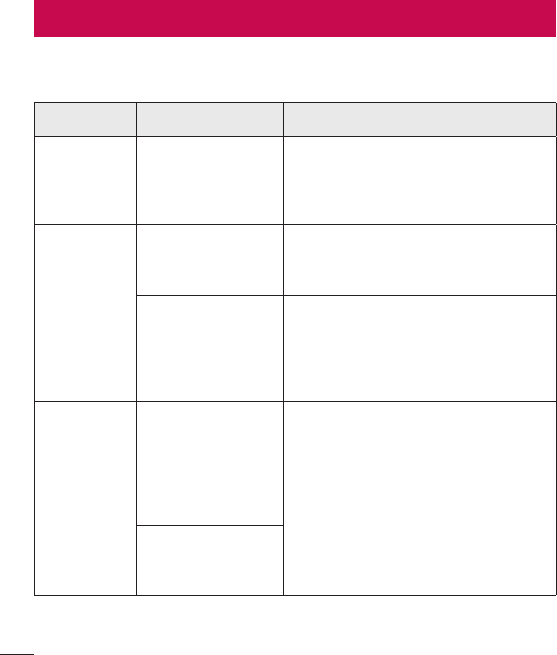
96 Troubleshooting
This chapter lists some problems you might encounter when using your phone. Some
problems require you to call your service provider, but most are easy to fix yourself.
Message Possible causes Possible corrective measures
SIM or
USIM card
error
There is no SIM
or USIM card in
the phone or it is
inserted incorrectly.
Make sure that the SIM or USIM card
is correctly inserted.
No network
connection/
Dropped
network
Signal is weak or
you are outside the
carrier network.
Move toward a window or into
an open area. Check the network
operator coverage map.
Operator applied
new services.
Check whether the SIM or USIM card
is more than 6~12 months old. If so,
change your SIM or USIM card at your
network provider's nearest branch.
Contact your service provider.
Codes do
not match
To change a
security code,
must need to
confirm the
new code by
re-entering it.
If you forget the code, contact your
service provider.
The two codes
you entered do not
match.
Troubleshooting
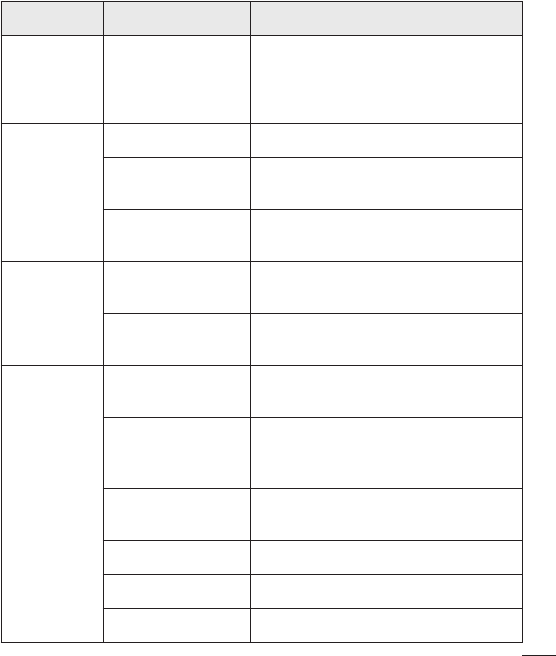
97
Troubleshooting
Message Possible causes Possible corrective measures
No
applications
can be set
Not supported by
service provider
or registration
required.
Contact your service provider.
Calls not
available
Dialing error New network not authorised.
New SIM or USIM
card inserted. Check for new restrictions.
Pre-paid charge
limit reached.
Contact service provider or reset limit
with PIN2.
Phone
cannot be
turned on
On/Off key pressed
too briefly.
Press the On/Off key for at least two
seconds.
Battery is not
charged.
Charge battery. Check the charging
indicator on the display.
Charging
error
Battery is not
charged. Charge battery.
Outside
temperature is too
hot or cold.
Make sure phone is charging at a
normal temperature.
Contact problem Check the charger and its connection
to the phone.
No voltage Plug the charger into a different outlet.
Charger defective Replace the charger.
Wrong charger Use only original LG accessories.
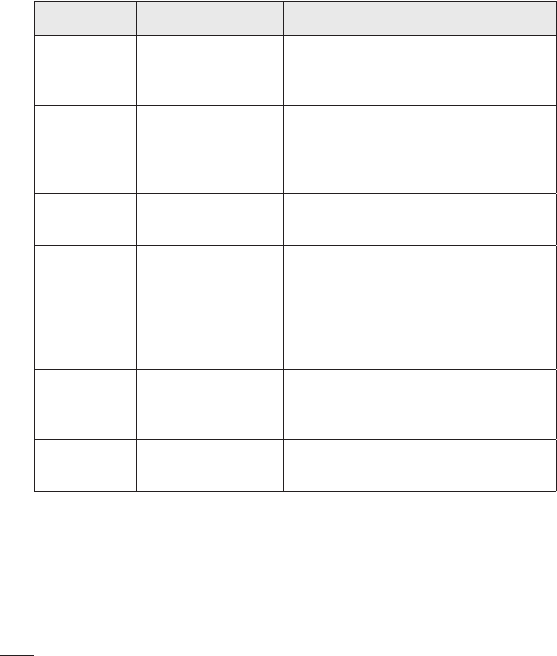
98 Troubleshooting
Message Possible causes Possible corrective measures
Number not
allowed.
The Fixed dialling
number function
is on.
Check the Settings menu and turn the
function off.
Impossible
to receive/
send SMS
& photos
Memory full Delete some messages from your
phone.
Files do not
open
Unsupported file
format Check the supported file formats.
The screen
does not
turn on
when I
receive a
call.
Proximity sensor
problem
If you use a protection tape or case,
make sure it has not covered the area
around the proximity sensor. Make
sure that the area around the proximity
sensor is clean.
No sound Vibration mode
Check the settings status in the sound
menu to make sure you are not in
vibration or no interruptions mode.
Hangs up
or freezes
Intermittent
software problem
Try to perform a software update
through the website.
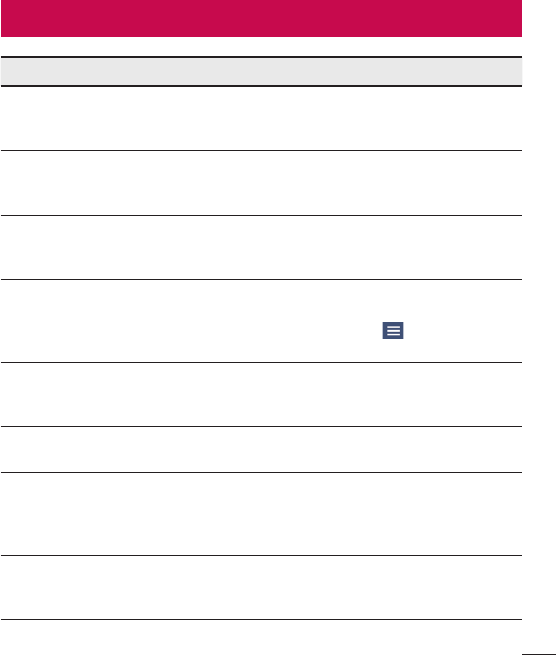
99
FAQ
Category Question Answer
Bluetooth
Devices
What functions
are available via
Bluetooth?
You can connect a Bluetooth audio
device, such as a Stereo/Mono
headset or car kit.
Contacts
Backup
How can I back up
Contacts?
Contacts data can be synchronised
between your phone and your Google
account.
Synchronization
Is it possible to set up
one-way sync with
Gmail?
Only two-way synchronization is
available.
Synchronization
Is it possible to
synchronise all email
folders?
The Inbox is automatically
synchronised. You can view other
folders by tapping and selecting
Show all folders to choose a folder.
Gmail Log-In
Do I have to log into
Gmail whenever I want
to access Gmail?
Once you have logged into Gmail, there
is no need to log into Gmail again.
Google
Account
Is it possible to filter
emails?
No, the phone does not support email
filtering.
Email
What happens when
I execute another
application while
writing an email?
Your email is automatically saved as
a draft.
Ringtone
Is there a file size limit
for using MP3 files as
ringtones?
There is no file size limit.
FAQ
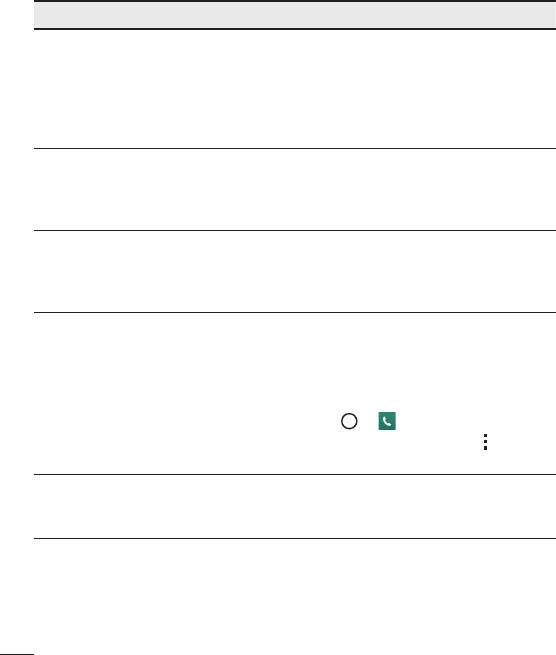
100 FAQ
Category Question Answer
Message
Time
My phone does not
display the time of
receipt for messages
older than 24 hrs.
How can I view the
time?
Open the conversation and touch and
hold the desired message. Then tap
Details.
Navigation
Is it possible to install
another navigation
application on my
phone?
Any application that is available at Play
Store™ and is compatible with the
hardware can be installed and used.
Synchronisation
Is it possible to
synchronise my
contacts from all my
email accounts?
Only Gmail and MS Exchange server
(company email server) contacts can
be synchronised.
Wait and
Pause
Is it possible to save
a contact with Wait
and Pause in the
numbers?
If you transferred a contact using the
Wait & Pause functions saved into the
number, you cannot use those features.
You must save each number again.
How to save with Wait and Pause:
1. Tap > .
2. Dial the number, then tap .
3. Tap Add 2-sec pause or Add wait.
Security What are the phone's
security functions?
You can set the phone to require an
Unlock Pattern to be entered before
the phone can be accessed or used.

101
FAQ
Category Question Answer
Unlock
Pattern
How do I create the
Unlock Pattern?
1. From the Home screen, touch and
hold .
2. Tap System settings > Display tab
> Lock screen.
3. Tap Select screen lock > Pattern.
The first time you do this, a short
tutorial about creating an Unlock
Pattern appears.
4. Set up your pattern by drawing it
then drawing it a second time for
confirmation.
Precautions to take when using the
pattern lock.
It is very important to remember the
unlock pattern you set. You can no
longer access your phone if you use
an incorrect pattern five times. You
have five chances to enter your unlock
pattern, PIN or password. If you have
used all 5 opportunities, you can try
again after 30 seconds. (Or, if you
preset the backup PIN, you can use
the backup PIN code to unlock the
pattern.)
Unlock
Pattern
What should I do if
I forget the unlock
pattern?
If you forgot your pattern:
If you logged into your Google account
on the phone but failed to enter the
correct pattern 5 times, tap the Forgot
pattern button. You are then required
to log in with your Google account to
unlock your phone.
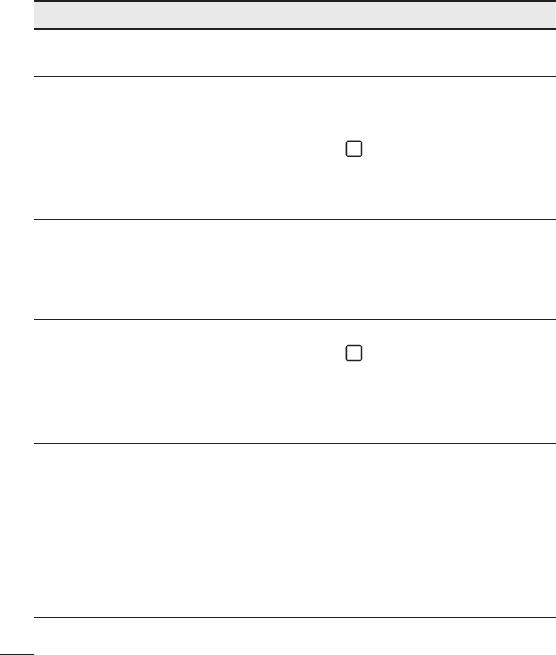
102 FAQ
Category Question Answer
Memory Will I know when my
memory is full? Yes, you will receive a notification.
Language
Support
Is it possible to
change my phone's
language?
The phone has multilingual capabilities.
To change the language:
1. From the Home screen, touch and
hold and tap System settings.
2. Tap General tab > Language &
input > Language.
3. Tap the desired language.
VPN How do I set up a
VPN?
VPN access configuration is different
for each company. To configure VPN
access on your phone, you must
obtain the details from your company's
network administrator.
Screen time
out
My screen turns off
after only 15 seconds.
How can I change the
amount of time for the
backlight to turn off?
1. From the Home screen, touch and
hold .
2. Tap System settings > Display tab.
3. Tap Screen timeout.
4. Tap the preferred screen backlight
timeout time.
Wi-Fi &
mobile
network
When the Wi-Fi and
mobile networks are
both available, which
service does my
phone use?
When using data, your phone may
default to the Wi-Fi connection (if Wi-Fi
connectivity on your phone is set to
On). However, there is no notification
when your phone switches from one to
the other.
To know which data connection is
being used, view the mobile network or
Wi-Fi icon at the top of your screen.
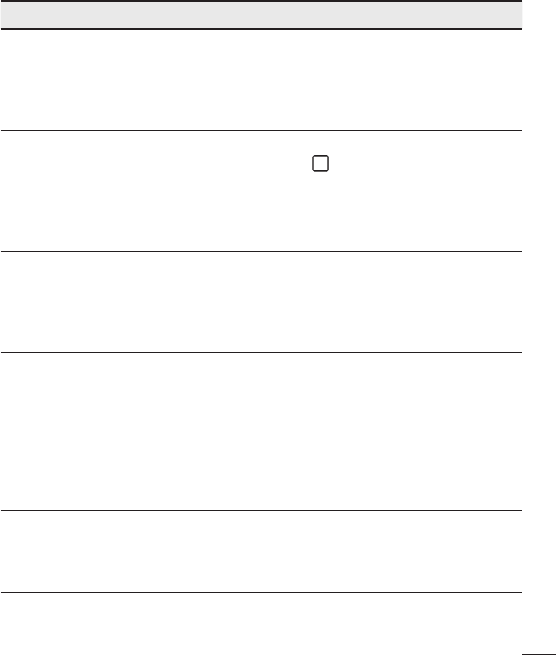
103
FAQ
Category Question Answer
Home
screen
Is it possible to
remove an application
from the Home
screen?
Yes. Just touch and hold the icon until
the trash can icon appears at the top
and centre of the screen. Then, without
lifting your finger, drag the icon to the
trash can.
Application
I downloaded an
application and it
causes a lot of errors.
How do I remove it?
1. From the Home screen, touch and
hold .
2. Tap System settings > General tab
> Apps > DOWNLOADED.
3. Tap the application, then tap
Uninstall.
Charger
Is it possible to charge
my phone using
a USB data cable
without installing the
necessary USB driver?
Yes, the phone is charged through the
USB cable regardless of whether the
necessary drivers are installed.
Alarm Can I use music files
for my alarm?
Yes. After saving a music file as a
ringtone, you can use it as an alarm.
1. Touch and hold a song in a library
list. In the menu that opens, tap
Setas ringtone > Phone ringtone
or Caller ringtones.
2. On the Alarm Clock Setting screen,
select the song as a ringtone.
Alarm
Will my alarm be
audible or will it go off
if the phone is turned
off?
No, this is not supported.

104 FAQ
Category Question Answer
Alarm
If my ringer volume
is set to vibrate, will I
hear my alarm?
Your alarm is programmed to be
audible even in these scenarios.
Hard Reset
(Factory
Reset)
How can I perform a
factory reset if I cannot
access the phone's
Settings menu?
If your phone does not restore to its
original condition, use a hard reset
(factory reset) to initialise it.

2-1
For your safetyFor your safety
Safety Information
Please read and observe the following information for safe and proper use of your
phone and to prevent damage.
WARNING! This product contains chemicals known to the State of California to cause
cancer and birth defects or reproductive harm.
Wash hands after handling.
Caution: Violation of the instructions may cause minor or serious
damage to the product.
t For your safety, do not remove the battery incorporated in the product.
t Do not disassemble or open crush, bend or deform, puncture or shred.
t Repairs under warranty, at LG’s option, may include replacement parts or boards
that are either new or reconditioned, provided that they have functionality equal to
that of the parts being replaced.
t Do not modify or remanufacture, attempt to insert foreign objects into the battery,
immerse or expose to water or other liquids, expose to fire, explosion or other
hazard.
t Avoid dropping the phone. If the phone is dropped, especially on a hard surface,
and the user suspects damage, take it to a service center for inspection.
t For those host devices that utilize a USB port as a charging source, the host
device’s user manual shall include a statement that the phone shall only be
connected to products that bear the USB-IF logo or have completed the USB-IF
compliance program.

2-2
Charger and Adapter Safety
t The charger and adapter are intended for indoor use only.
t Insert the battery pack charger vertically into the wall power socket.
t Unplug the power cord and charger during lightning storms to avoid electric shock
or fire.
t Use the correct adapter for your phone when using the battery pack charger
abroad.
Battery Information and Care
t Please read the manual of specified charger about charging method.
t Do not damage the power cord by bending, twisting, or heating. Do not use the
plug if it is loose as it may cause electric shock or fire. Do not place any heavy
items on the power cord. Do not allow the power cord to be crimped as it may
cause electric shock or fire.
t Unplug the power cord prior to cleaning your phone, and clean the power plug
pin when it’s dirty. When using the power plug, ensure that it’s firmly connected. If
not, it may cause excessive heat or fire. If you put your phone in a pocket or bag
without covering the receptacle of the phone (power plug pin), metallic articles
(such as a coin, paperclip or pen) may short-circuit the phone. Short-circuit of
the terminal may damage the battery and cause an explosion. Always cover the
receptacle when not in use.
t Charging temperature range is between 0°C/32°F and 45°C /113 °F. Do not
charge the battery out of recommended temperature range. Charging out of
recommended range might cause the generating heat or serious damage of

2-3
For your safety
battery. And also, it might cause the deterioration of battery’s characteristics and
cycle life.
t The battery pack has protection circuit to avoid the danger. Do not use near places
that can generate static electricity more than 100V which could damage the
protection circuit. Damaged protection circuits may generate smoke, rupture or
ignite.
t When using the battery for the first time, if it emits a bad smell, you see rust on it,
or anything else abnormal, do not use the equipment and bring the battery to the
shop which it was bought.
t Do not handle the phone with wet hands while it is being charged. It may cause an
electric shock or seriously damage your phone.
t Do not place or answer calls while charging the phone as it may short-circuit the
phone and/or cause electric shock or fire.
t Do not use harsh chemicals (such as alcohol, benzene, thinners, etc.) or detergents
to clean your phone. This could cause a fire.
t Always unplug the charger from the wall socket after the phone is fully charged to
save unnecessary power consumption of the charger.
Care and Maintenance
Your mobile device is a product of superior design and craftsmanship and should be
treated with care. The suggestions below will help you fulfill any warranty obligations
and allow you to enjoy this product for many years:

2-4
Keep your Mobile Device away from:
Liquids of any kind
Keep the mobile device dry. Precipitation, humidity, and liquids contain minerals that
will corrode electronic circuits. If the mobile device does get wet, do not accelerate
drying with the use of an oven, microwave, or dryer, because this may damage the
mobile device and could cause a fire or explosion.
Do not use the mobile device with a wet hand.
Doing so may cause an electric shock to you or damage to the mobile device.
Extreme heat or cold
t Avoid temperatures below 0°C /32°F or above 45°C /113°F.
t Use your phone in temperatures between 0°C /32°F and 40°C /104°F, if possible.
Exposing your phone to extremely low or high temperatures may result in damage,
malfunction, or even explosion.
Microwaves
Do not try to dry your mobile device in a microwave oven. Doing so may cause a fire
or explosion.
Dust and dirt
Do not expose your mobile device to dust, dirt, or sand.
Sunscreen lotion
Do not expose or wear your device to any liquid like sunscreen lotion.
Doing so may cause your device to or damage to the mobile device.

2-5
For your safety
Cleaning solutions
Do not use harsh chemicals, cleaning solvents, or strong detergents to clean the
mobile device.
Wipe it with a soft cloths lightly dampened in a mild soap-and-water solution.
Shock or vibration
Do not drop, knock, or shake the mobile device.
Rough handling can break internal circuit boards.
Paint
Do not paint the mobile device. Paint can clog the device’smoving parts or ventilation
openings and prevent proper operation.
General Notice
t An emergency call can be made only within a service area. For an emergency call,
make sure that you are within a service area and that the phone is turned on.
t Do not place items containing magnetic components such as a credit card, phone
card, bank book, or subway ticket near your phone. The magnetism of the phone
may damage the data stored in the magnetic strip.
t Talking on your phone for a long period of time may reduce call quality due to heat
generated during use.
t When the phone is not used for a long period time, store it in a safe place with the
power cord unplugged.
t Using the phone in proximity to receiving equipment (i.e., TV or radio) may cause
interference to the phone.

2-6
t Do not use the phone if the antenna is damaged. If a damaged antenna contacts
skin, it may cause a slight burn. Please contact an LG Authorized Service Center to
replace the damaged antenna.
t The data saved in your phone might be deleted due to careless use, repair of the
phone, or upgrade of the software. Please backup your important phone numbers.
(Ringtones, text messages, voice messages, pictures, and videos could also be
deleted.) The manufacturer is not liable for damage due to the loss of data.
t When you use the phone in public places, set the ringtone to vibration so you don’t
disturb others.
t Do not turn your phone on or off when putting it to your ear.
t Your phone is an electronic device that generates heat during normal operation.
Extremely prolonged, direct skin contact in the absence of adequate ventilation may
result in discomfort or minor burns. Therefore, use care when handling your phone
during or immediately after operation.
Use accessories, such as earphones and headsets, with caution. Ensure that cables
are tucked away safely and do not touch the antenna unnecessarily.
Part 15.19 statement
This device complies with part 15 of FCC rules. Operation is subject to the following
two conditions:
(1) This device may not cause harmful interference, and (2) this device must accept
any interference received, including interference that causes undesired operation.

2-7
For your safety
Bodily Contact During Operation
This device was tested for typical use with the back of the phone kept 0.39 inches
(1.0 cm) from the body. To comply with FCC RF exposure requirements, a
minimum separation distance of 0.39 inches (1.0 cm) must be maintained between
the user’s body and the back of the phone. Belt-clips, holsters, and similar
accessories containing metallic components may not be used. Avoid the use of
accessories that cannot maintain 0.39 inches (1.0 cm) distance between the user’s
body and the back of the phone and have not been tested for compliance with FCC
RF exposure limits.
Consumer Information About Radio Frequency Emissions
Your wireless phone, which contains a radio transmitter and receiver, emits radio
frequency energy during use. The following consumer information addresses
commonly asked questions about the health effects of wireless phones.
Are wireless phones safe?
Scientific research on the subject of wireless phones and radio frequency (“RF”)
energy has been conducted worldwide for many years, and continues. In the United
States, the Food and Drug Administration (“FDA”) and the Federal Communications
Commission (“FCC”) set policies and procedures for wireless phones. The FDA issued
a website publication on health issues related to cell phone usage where it states,
“The scientific community at large …believes that the weight of scientific evidence
does not show an association between exposure to radiofrequency (RF) from cell
phones and adverse health outcomes. Still the scientific community does recommend
conducting additional research to address gaps in knowledge. That research is being

2-8
conducted around the world and FDA continues to monitor developments in this
field. You can access the joint FDA/FCC website at http://www.fda.gov (under “c”
in the subject index, select Cell Phones > Research). You can also contact the FDA
toll-free at (888) 463-6332 or (888) INFO-FDA. In June 2000, the FDA entered into a
cooperative research and development agreement through which additional scientific
research is being conducted. The FCC issued its own website publication stating
that “there is no scientific evidence that proves that wireless phone usage can lead
to cancer or a variety of other problems, including headaches, dizziness or memory
loss.” This publication is available at http://www.fcc.gov/cgb/cellular.html or through
the FCC at (888) 225-5322 or (888) CALL-FCC.
What does “SAR” mean?
In 1996, the FCC, working with the FDA, the U.S. Environmental Protection Agency,
and other agencies, established RF exposure safety guidelines for wireless phones in
the United States. Before a wireless phone model is available for sale to the public,
it must be tested by the manufacturer and certified to the FCC that it does not
exceed limits established by the FCC. One of these limits is expressed as a Specific
Absorption Rate, or “SAR.” SAR is a measure of the rate of absorption of RF energy
in the body. Tests for SAR are conducted with the phone transmitting at its highest
power level in all tested frequency bands. Since 1996, the FCC has required that the
SAR of handheld wireless phones not exceed 1.6 watts per kilogram, averaged over
one gram of tissue. Although the SAR is determined at the highest power level, the
actual SAR value of a wireless phone while operating can be less than the reported
SAR value. This is because the SAR value may vary from call to call, depending on
factors such as proximity to a cell site, the proximity of the phone to the body while

2-9
For your safety
in use, and the use of hands-free devices. For more information about SARs, see the
FCC’s OET Bulletins 56 and 65 at http://www.fcc.gov/Bureaus/
Engineering_Technology/Documents/bulletins or visit the Cellular Telecommunications
Industry Association website at http://www.ctia.org/consumer_info/index.cfm/
AID/10371. You may also wish to contact the manufacturer of your phone.
Can I minimize my RF exposure?
If you are concerned about RF, there are several simple steps you can take to
minimize your RF exposure. You can, of course, reduce your talk time. You can place
more distance between your body and the source of the RF, as the exposure level
drops off dramatically with distance. The FDA/FCC website states that “hands-free
kits can be used with wireless phones for convenience and comfort. These systems
reduce the absorption of RF energy in the head because the phone, which is the
source of the RF emissions, will not be placed against the head. On the other hand,
if the phone is mounted against the waist or other part of the body during use, then
that part of the body will absorb more RF energy. Wireless phones marketed in the
U.S. are required to meet safety requirements regardless of whether they are used
against the head or against the body. Either configuration should result in compliance
with the safety limit.”Also, if you use your wireless phone while in a car, you can use
a phone with an antenna on the outside of the vehicle. You should also read and
follow your wireless phone manufacturer’s instructions for the safe operation of your
phone.

2-10
Do wireless phones pose any special risks to children?
The FDA/FCC website states that “the scientific evidence does not show a danger to
users of wireless communication devices, including children.” The FDA/FCC website
further states that “some groups sponsored by other national governments have
advised that children be discouraged from using wireless phones at all”. For example,
the Stewart Report from the United Kingdom [“UK”] made such a recommendation
in December 2000. In this report a group of independent experts noted that no
evidence exists that using a cell phone causes brain tumors or other ill effects. [The
UK’s] recommendation to limit cell phone use by children was strictly precautionary;
it was not based on scientific evidence that any health hazard exists. A copy of the
UK’s leaflet is available at http://www.dh.gov.uk (search “mobile”), or you can write to:
NRPB, Chilton, Didcot, Oxon OX11 ORQ, United Kingdom. Copies of the UK’s annual
reports on mobile phones and RF are available online at www.iegmp.org.uk and
http://www.hpa.org.uk/radiation/ (search “mobile”). Parents who wish to reduce their
children’s RF exposure may choose to restrict their children’s wireless phone use.
Where can I get further information about RF emissions?
For further information, see the following additional resources (websites current as of
April 2005):
U.S. Food and Drug Administration
FDA Consumer magazine November-December 2000 Telephone: (888) INFO-FDA
http://www.fda.gov (Under “c”in the subject index, select Cell Phones > Research.)

2-11
For your safety
U.S. Federal Communications Commission
445 12th Street, S.W. Washington, D.C. 20554 Telephone: (888) 225-5322 http://
www.fcc.gov/oet/rfsafety
Independent Expert Group on Mobile Phones
http://www.iegmp.org.uk
Royal Society of Canada Expert Panels on Potential
Health Risks of Radio Frequency Fields from Wireless
Telecommunication Devices
283 Sparks Street Ottawa, Ontario K1R 7X9 Canada Telephone: (613) 991-6990
http://www.rsc.ca/index.php?page=Expert_Panels_RF&Lang_id=120
World Health Organization
Avenue Appia 20
1211 Geneva 27
Switzerland
Telephone: 011 41 22 791 21 11
http://www.who.int/mediacentre/factsheets/fs193/en/
International Commission on Non-Ionizing
Radiation Protection c/o Bundesamt fur Strahlenschutz
Ingolstaedter Landstr. 1
85764 Oberschleissheim

2-12
Germany
Telephone: 011 49 1888 333 2156
http://www.icnirp.de
American National Standards Institute
1819 L Street, N.W., 6th Floor
Washington, D.C. 20036
Telephone: (202) 293-8020
http://www.ansi.org
National Council on Radiation Protection and Measurements
7910 Woodmont Avenue, Suite 800
Bethesda, MD 20814-3095
Telephone: (301) 657-2652
http://www.ncrponline.org
Engineering in Medicine and Biology Society, Committee on
Man and Radiation (COMAR) of the Institute of Electrical and
Electronics Engineers
http://ewh.ieee.org/soc/embs/comar/
TIA Safety Information
The following is the complete TIA Safety Information for wireless handheld phones.

2-13
For your safety
Exposure to Radio Frequency Signal
Your wireless handheld portable phone is a low power radio transmitter and receiver.
When ON, it receives and sends out Radio Frequency (RF) signals.
In August, 1996, the Federal Communications Commissions (FCC) adopted RF
exposure guidelines with safety levels for handheld wireless phones. Those guidelines
are consistent with the safety standards previously set by both U.S. and international
standards bodies:
ANSI C95.1 (1992) *
NCRP Report 86 (1986)
ICNIRP (1996)
* American National Standards Institute; National Council on Radiation Protection and
Measurements; International Commission on Non-Ionizing Radiation Protection
Those standards were based on comprehensive and periodic evaluations of the
relevant scientific literature. For example, over 120 scientists, engineers, and
physicians from universities, government health agencies, and industry reviewed the
available body of research to develop the ANSI Standard (C95.1).
The design of your phone complies with the FCC guidelines (and those standards).

2-14
Tips on Efficient Operation
For your phone to operate most efficiently:
Don’t touch the antenna unnecessarily when the phone is in use. Contact with the
antenna affects call quality and may cause the phone to operate at a higher power
level than otherwise needed.
Electronic Devices
Most modern electronic equipment is shielded from RF signals. However, certain
electronic equipment may not be shielded against the RF signals from your wireless
phone.
Pacemakers
The Health Industry Manufacturers Association recommends that a minimum
separation of six (6) inches be maintained between a handheld wireless
phone and a pacemaker to avoid potential interference with the pacemaker.
These recommendations are consistent with the independent research by and
recommendations of Wireless Technology Research.
Persons with pacemakers:
t Should ALWAYS keep the phone more than six (6) inches from their pacemaker
when the phone is turned ON;
t Should not carry the phone in a breast pocket;
t Should use the ear opposite the pacemaker to minimize the potential for
interference;
t Should turn the phone OFF immediately if there is any reason to suspect that
interference is taking place.

2-15
For your safety
Hearing Aids
Some digital wireless phones may interfere with some hearing aids. In the event of
such interference, you may want to consult your service provider (or call the customer
service line to discuss alternatives).
Other Medical Devices
If you use any other personal medical device, consult the manufacturer of your device
to determine if it is adequately shielded from external RF energy. Your physician may
be able to assist you in obtaining this information.
Health Care Facilities
Turn your phone OFF in health care facilities when any regulations posted in these
areas instruct you to do so. Hospitals or health care facilities may use equipment that
could be sensitive to external RF energy.
Vehicles
RF signals may affect improperly installed or inadequately shielded electronic systems
in motor vehicles. Check with the manufacturer or its representative regarding your
vehicle. You should also consult the manufacturer of any equipment that has been
added to your vehicle.
Posted Facilities
Turn your phone OFF in any facility where posted notices so require.
Aircraft
FCC regulations prohibit using your phone while in the air. Switch OFF your phone
before boarding an aircraft.

2-16
Blasting Areas
To avoid interfering with blasting operations, turn your phone OFF when in a “blasting
area” or in areas posted: “Turn off two-way radio”. Obey all signs and instructions.
Potentially Explosive Atmosphere
Turn your phone OFF when in any area with a potentially explosive atmosphere and
obey all signs and instructions. Sparks in such areas could cause an explosion or fire
resulting in bodily injury or even death.
Areas with a potentially explosive atmosphere are often, but not always marked
clearly. Potential areas may include: fueling areas (such as gasoline stations); below
deck on boats; fuel or chemical transfer or storage facilities; vehicles using liquefied
petroleum gas (such as propane or butane); areas where the air contains chemicals
or particles (such as grain, dust, or metal powders); and any other area where you
would normally be advised to turn off your vehicle engine.
For Vehicles Equipped with an Air Bag
An air bag inflates with great force. DO NOT place objects, including either installed
or portable wireless equipment, in the area over the air bag or in the air bag
deployment area. If in-vehicle wireless equipment is improperly installed and the air
bag inflates, serious injury could result.
FDA Consumer Update
The U.S. Food and Drug Administration’s Center for Devices and
Radiological Health Consumer Update on Mobile Phones:

2-17
For your safety
1. Do wireless phones pose a health hazard?
The available scientific evidence does not show that any health problems are
associated with using wireless phones.
There is no proof, however, that wireless phones are absolutely safe. Wireless phones
emit low levels of Radio Frequency (RF) energy in the microwave range while being
used. They also emit very low levels of RF when in idle mode. Whereas high levels
of RF can produce health effects (by heating tissue), exposure to low level RF that
does not produce heating effects causes no known adverse health effects. Many
studies of low level RF exposures have not found any biological effects. Some studies
have suggested that some biological effects may occur, but such findings have not
been confirmed by additional research. In some cases, other researchers have had
difficulty in reproducing those studies, or in determining the reasons for inconsistent
results.
2. What is the FDA’s role concerning the safety of wireless phones?
Under the law, the FDA does not review the safety of radiation-emitting consumer
products such as wireless phones before they can be sold, as it does with new drugs
or medical devices. However, the agency has authority to take action if wireless
phones are shown to emit Radio Frequency (RF) energy at a level that is hazardous to
the user. In such a case, the FDA could require the manufacturers of wireless phones
to notify users of the health hazard and to repair, replace, or recall the phones so that
the hazard no longer exists.
Although the existing scientific data does not justify FDA regulatory actions, the
FDA has urged the wireless phone industry to take a number of steps, including the
following:

2-18
t Support needed research into possible biological effects of RF of the type emitted
by wireless phones;
t Design wireless phones in a way that minimizes any RF exposure to the user that is
not necessary for device function; and
t Cooperate in providing users of wireless phones with the best possible information
on possible effects of wireless phone use on human health.
The FDA belongs to an interagency working group of the federal agencies that have
responsibility for different aspects of RF safety to ensure coordinated efforts at the
federal level. The following agencies belong to this working group:
t National Institute for Occupational Safety and Health
t Environmental Protection Agency
t Occupational Safety and Health Administration
t National Telecommunications and Information Administration
The National Institutes of Health participates in some interagency working group
activities, as well.
The FDA shares regulatory responsibilities for wireless phones with the Federal
Communications Commission (FCC). All phones that are sold in the United States
must comply with FCC safety guidelines that limit RF exposure. The FCC relies on the
FDA and other health agencies for safety questions about wireless phones.
The FCC also regulates the base stations that the wireless phone networks rely upon.
While these base stations operate at higher power than do the wireless phones
themselves, the RF exposures that people get from these base stations are typically
thousands of times lower than those they can get from wireless phones. Base
stations are thus not the subject of the safety questions discussed in this document.

2-19
For your safety
3. What kinds of phones are the subject of this update?
The term “wireless phone” refers here to handheld wireless phones with built-in
antennas, often called “cell”, “mobile”, or “PCS” phones. These types of wireless
phones can expose the user to measurable Radio Frequency (RF) energy because
of the short distance between the phone and the user’s head. These RF exposures
are limited by FCC safety guidelines that were developed with the advice of the
FDA and other federal health and safety agencies. When the phone is located at
greater distances from the user, the exposure to RF is drastically lower because a
person’s RF exposure decreases rapidly with increasing distance from the source.
The so-called “cordless phones,” which have a base unit connected to the telephone
wiring in a house, typically operate at far lower power levels, and thus produce RF
exposures far below the FCC safety limits.
4. What are the results of the research done already?
The research done thus far has produced conflicting results, and many studies have
suffered from flaws in their research methods. Animal experiments investigating the
effects of Radio Frequency (RF) energy exposures characteristic of wireless phones
have yielded conflicting results that often cannot be repeated in other laboratories. A
few animal studies, however, have suggested that low levels of RF could accelerate
the development of cancer in laboratory animals. However, many of the studies
that showed increased tumor development used animals that had been genetically
engineered or treated with cancer-causing chemicals so as to be pre-disposed to
develop cancer in the absence of RF exposure. Other studies exposed the animals
to RF for up to 22 hours per day. These conditions are not similar to the conditions
under which people use wireless phones, so we do not know with certainty what the
results of such studies mean for human health. Three large epidemiology studies

2-20
have been published since December 2000. Between them, the studies investigated
any possible association between the use of wireless phones and primary brain
cancer, glioma, meningioma, or acoustic neuroma, tumors of the brain or salivary
gland, leukemia, or other cancers. None of the studies demonstrated the existence of
any harmful health effects from wireless phone RF exposures. However, none of the
studies can answer questions about long-term exposures, since the average period of
phone use in these studies was around three years.
5. What research is needed to decide whether RF exposure from wireless
phones poses a health risk?
A combination of laboratory studies and epidemiological studies of people actually
using wireless phones would provide some of the data that are needed. Lifetime
animal exposure studies could be completed in a few years. However, 166 very large
numbers of animals would be needed to provide reliable proof of a cancer promoting
effect if one exists. Epidemiological studies can provide data that is directly applicable
to human populations, but ten or more years followup may be needed to provide
answers about some health effects, such as cancer. This is because the interval
between the time of exposure to a cancercausing agent and the time tumors develop
— if they do — may be many, many years. The interpretation of epidemiological
studies is hampered by difficulties in measuring actual RF exposure during day-to-
day use of wireless phones. Many factors affect this measurement, such as the angle
at which the phone is held, or which model of phone is used.
6. What is the FDA doing to find out more about the possible health effects of
wireless phone RF?
The FDA is working with the U.S. National Toxicology Program and with groups
of investigators around the world to ensure that high priority animal studies are

2-21
For your safety
conducted to address important questions about the effects of exposure to Radio
Frequency (RF) energy.
The FDA has been a leading participant in the World Health Organization International
Electro Magnetic Fields (EMF) Project since its inception in 1996. An influential result
of this work has been the development of a detailed agenda of research needs
that has driven the establishment of new research programs around the world. The
project has also helped develop a series of public information documents on EMF
issues.
The FDA and the Cellular Telecommunications & Internet Association (CTIA) have a
formal Cooperative Research And Development Agreement (CRADA)
to do research on wireless phone safety. The FDA provides the scientific oversight,
obtaining input from experts in government, industry, and academic organizations.
CTIA-funded research is conducted through contracts with independent investigators.
The initial research will include both laboratory studies and studies of wireless phone
users. The CRADA will also include a broad assessment of additional research needs
in the context of the latest research developments around the world.
7. How can I find out how much Radio Frequency energy exposure I can get by
using my wireless phone?
All phones sold in the United States must comply with Federal Communications
Commission (FCC) guidelines that limit Radio Frequency (RF) energy exposures. The
FCC established these guidelines in consultation with the FDA and the other federal
health and safety agencies. The FCC limit for RF exposure from wireless phones is
set at a Specific Absorption Rate (SAR) of 1.6 watts per kilogram (1.6 W/kg). The FCC
limit is consistent with the safety standards developed by the Institute of Electrical
and Electronic Engineering (IEEE) and the National Council on Radiation Protection

2-22
and Measurement. The exposure limit takes into consideration the body’s ability to
remove heat from the tissues that absorb energy from the wireless phone and is
set well below levels known to have effects. Manufacturers of wireless phones must
report the RF exposure level for each model of phone to the FCC. The FCC website
(http://www.fcc.gov/oet/rfsafety) gives directions for locating the FCC identification
number on your phone so you can find your phone’s RF exposure
level in the online listing.
8. What has the FDA done to measure the Radio Frequency energy coming
from wireless phones?
The Institute of Electrical and Electronic Engineers (IEEE) is developing a technical
standard for measuring the Radio Frequency (RF) energy exposure from wireless
phones and other wireless handsets with the participation and leadership of FDA
scientists and engineers. The standard, “Recommended Practice for Determining
the Spatial-Peak Specific Absorption Rate (SAR) in the Human Body Due to Wireless
Communications Devices: Experimental Techniques”, sets forth the first consistent
test methodology for measuring the rate at which RF is deposited in the heads
of wireless phone users. The test method uses a tissue-simulating model of the
human head. Standardized SAR test methodology is expected to greatly improve the
consistency of measurements made at different laboratories on the same phone. SAR
is the measurement of the amount of energy absorbed in tissue, either by the whole
body or a small part of the body. It is measured in watts/kg (or milliwatts/g) of matter.
This measurement is used to determine whether a wireless phone complies with
safety guidelines.

2-23
For your safety
9. What steps can I take to reduce my exposure to Radio Frequency energy
from my wireless phone?
If there is a risk from these products — and at this point we do not know that
there is — it is probably very small. But if you are concerned about avoiding even
potential risks, you can take a few simple steps to minimize your exposure to Radio
Frequency (RF) energy. Since time is a key factor in how much exposure a person
receives, reducing the amount of time spent using a wireless phone will reduce RF
exposure. If you must conduct extended conversations by wireless phone every day,
you could place more distance between your body and the source of the RF, since
the exposure level drops off dramatically with distance. For example, you could use a
headset and carry the wireless phone away from your body or use a wireless phone
connected to a remote antenna. Again, the scientific data does not demonstrate that
wireless phones are harmful. But if you are concerned about the RF exposure from
these products, you can use measures like those described above to reduce your RF
exposure from wireless phone use.
10. What about children using wireless phones?
The scientific evidence does not show a danger to users of wireless phones,
including children and teenagers. If you want to take steps to lower exposure to
Radio Frequency (RF) energy, the measures described above would apply to children
and teenagers using wireless phones. Reducing the time of wireless phone use and
increasing the distance between the user and the RF source will reduce RF exposure.
Some groups sponsored by other national governments have advised that children be
discouraged from using wireless phones at all. For example, the government in the
United Kingdom distributed leaflets containing such a recommendation in December
2000. They noted that no evidence exists that using a wireless phone causes brain

2-24
tumors or other ill effects. Their recommendation to limit wireless phone use by
children was strictly precautionary; it was not based on scientific evidence that any
health hazard exists.
11. What about wireless phone interference with medical equipment?
Radio Frequency (RF) energy from wireless phones can interact with some electronic
devices. For this reason, the FDA helped develop a detailed test method to
measure Electro Magnetic Interference (EMI) of implanted cardiac pacemakers and
defibrillators from wireless telephones. This test method is now part of a standard
sponsored by the Association for the Advancement of Medical Instrumentation (AAMI).
The final draft, a joint effort by the FDA, medical device manufacturers, and many
other groups, was completed in late 2000. This standard will allow manufacturers to
ensure that cardiac pacemakers and defibrillators are safe from wireless phone EMI.
The FDA has tested hearing aids for interference from handheld wireless phones
and helped develop a voluntary standard sponsored by the Institute of Electrical and
Electronic Engineers (IEEE). This standard specifies test methods and performance
requirements for hearing aids and wireless phones so that no interference occurs
when a person uses a “compatible” phone and a “compatible” hearing aid at the
same time. This standard was approved by the IEEE in 2000.
The FDA continues to monitor the use of wireless phones for possible interactions
with other medical devices. Should harmful interference be found to occur, the FDA
will conduct testing to assess the interference and work to resolve the problem.
12. Where can I find additional information?
For additional information, please refer to the following resources:
Federal Communications Commission (FCC) RF Safety Program
(http://www.fcc.gov/oet/rfsafety)

2-25
For your safety
International Commission on Non-lonizing Radiation Protection
(http://www.icnirp.de)
World Health Organization (WHO) International EMF Project
(http://www.who.int/emf)
National Radiological Protection Board (UK)
(http://www.hpa.org.uk/radiation/)
Driving
Check the laws and regulations on the use of wireless phones in the areas where you
drive and always obey them. Also, if using your phone while driving, please observe
the following:
t Give full attention to driving -- driving safely is your first responsibility;
t Use hands-free operation, if available;
t Pull off the road and park before making or answering a call if driving conditions or
the law require it.
Consumer Information on SAR
(Specific Absorption Rate)
This model phone meets the Government’s requirements for exposure to radio
waves. Your wireless phone is a radio transmitter and receiver. It is designed and
manufactured not to exceed the emission limits for exposure to radiofrequency
(RF) energy set by the Federal Communications Commission (FCC) of the U.S.
Government. These FCC exposure limits are derived from the recommendations
of two expert organizations, the National Counsel on Radiation Protection and

2-26
Measurement (NCRP) and the Institute of Electrical and Electronics Engineers (IEEE).
In both cases, the recommendations were developed by scientific and engineering
experts drawn from industry, government, and academia after extensive reviews of
the scientific literature related to the biological effects of RF energy.
The exposure limit for wireless mobile phones employs a unit of measurement
known as the Specific Absorption Rate, or SAR. The SAR is a measure of the rate of
absorption of RF energy by the human body expressed in units of watts per kilogram
(W/kg). The FCC requires wireless phones to comply with a safety limit of 1.6 watts
per kilogram (1.6 W/kg). The FCC exposure limit incorporates a substantial margin of
safety to give additional protection to the public and to account for any variations in
measurements.
Tests for SAR are conducted using standard operating positions specified by the FCC
with the phone transmitting at its highest certified power level in all tested frequency
bands. Although SAR is determined at the highest certified power level, the actual
SAR level of the phone while operating can be well below the maximum value.
Because the phone is designed to operate at multiple power levels to use only the
power required to reach the network, in general, the closer you are to a wireless base
station antenna, the lower the power output.
Before a phone model is available for sale to the public, it must be tested and
certified to the FCC that it does not exceed the limit established by the government
adopted requirement for safe exposure. The tests are performed in positions and
locations (e.g., at the ear and worn on the body) as required by the FCC for each
model.
The FCC has granted an Equipment Authorization for this model phone with all
reported SAR levels evaluated as in compliance with the FCC RF emission guidelines.

2-27
Part 15.105 statement
This equipment has been tested and found to comply with the limits for a class
B digital device, pursuant to Part 15 of the FCC rules. These limits are designed
to provide reasonable protection against harmful interference in a residential
installation. This equipment generates, uses, and can radiate radio frequency
energy and, if not installed and used in accordance with the instructions, may cause
harmful interference to radio communications. However, there is no guarantee that
interference will not occur in a particular installation. If this equipment does cause
harmful interference or television reception, which can be determined by turning the
equipment off and on, the user is encouraged to try to correct the interference by one
or more of the following measures:
- Reorient or relocate the receiving antenna.
- Increase the separation between the equipment and receiver.
- Connect the equipment into an outlet on a circuit different from that to which the
receiver is connected.
- Consult the dealer or an experienced radio/TV technician for help.
Part 15.21 statement
Changes or modifications that are not expressly approved by the manufacturer could
void the user’s authority to operate the equipment.
Battery information and care
Always unplug the charger from the wall socket after the phone is fully charged to
save unnecessary power consumption of the charger.